4 Days in London: A Perfect Itinerary for First Timers
When we booked a last minute trip to London a few years ago – our first time back in the city for a few years (we’ve since been back again) – we weren’t entirely sure what to expect.
We had both been to London before, though not for a few years, and we decided two weeks would be a comfortable amount of time to explore the city, and maybe take a day trip or two to explore other parts of the United Kingdom.
Turns out, we never left the city and STILL ended up having things within the city that we didn’t get to (so Matt returned this past fall to spend another 10 days exploring).
It’s one of our favorite cities in the world, and we will absolutely be back again every few years.
London is huge, and there’s a ton to do and see, so the hardest part about planning a trip to London is choosing between attractions.
That’s where we come in.
In this guide, which is based on our recent experiences exploring London, we’re going to give you our take on what you should prioritize in London. Along with what you shouldn’t.
Our favorite parts about London were the diverse range of food stalls at the innumerable food markets around the city, the city’s great green spaces, and the amount of history that exists in London (most of which we didn’t really know about, because to us, London history starts in the 16th Century according to what we learned in school).
In this guide to planning your trip to London, you’ll find a detailed 4 day London itinerary, complete with things to do, see, eat, and drink, along with the important details you need to know like how to see Westminster Cathedral and the best way to tackle the beast that is the British Museum.
You’ll also find logistics – like how to get around and some useful tips and tricks for visiting London – that are important for planning your trip.
We hope you enjoy this guide, that you find it helpful for planning your trip, and we help you discover something new and exciting, whether it’s your first time, or tenth.
Sound good to you? Let’s get into it.
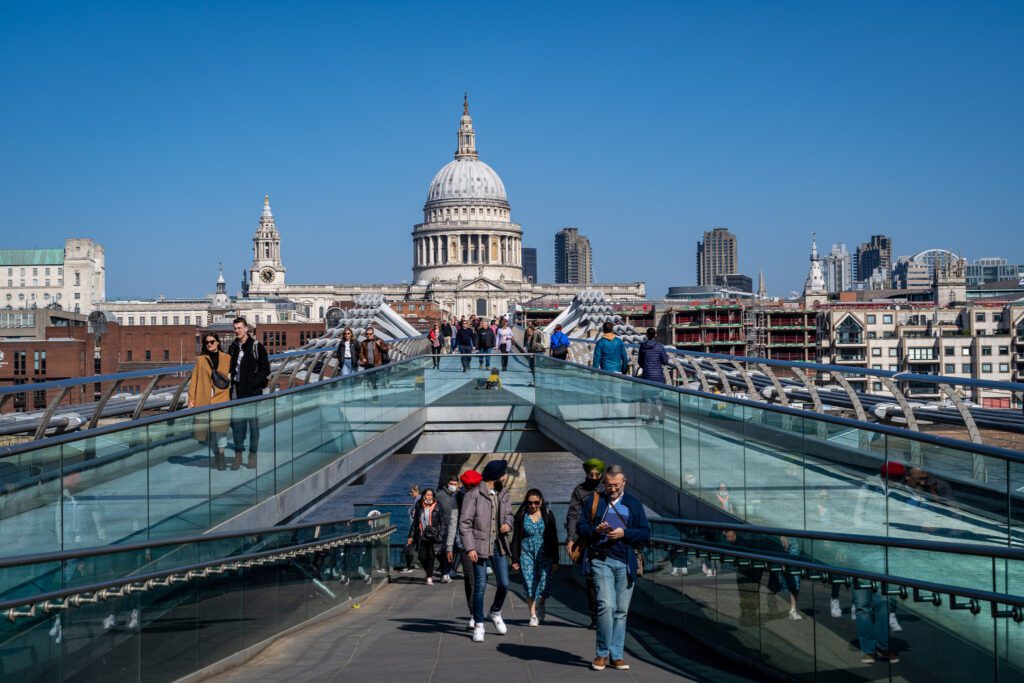
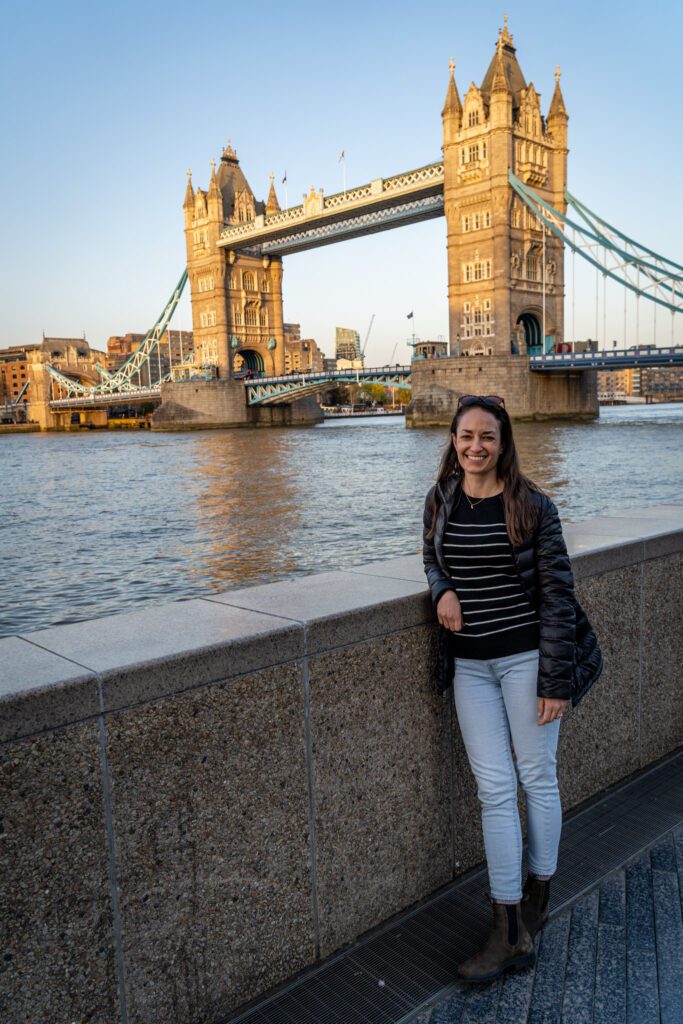
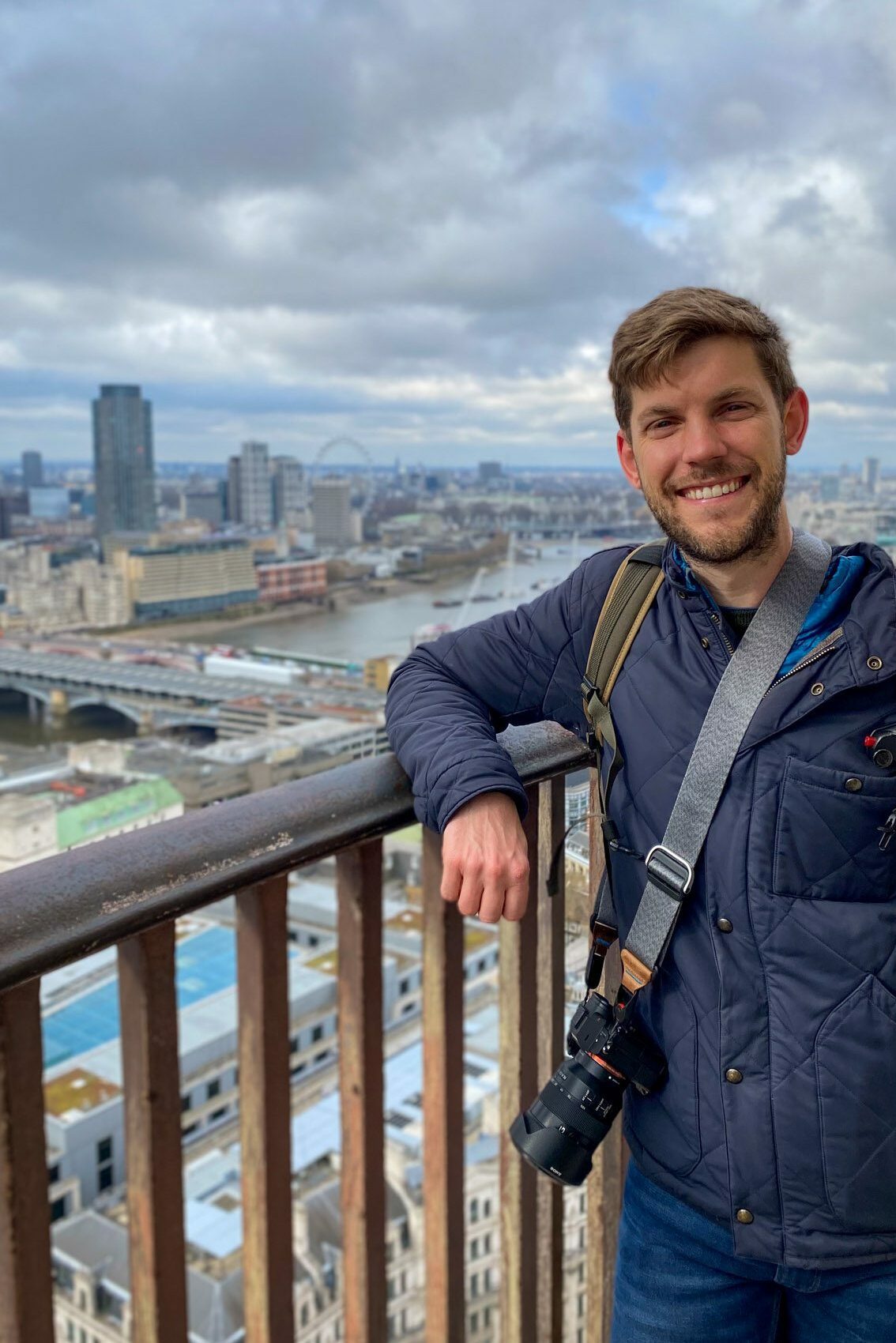
Disclaimer: Some of the links in this post, like hotel links, are affiliate links, meaning at no additional cost to you, we make a little bit of money if you click through and book. That being said, we would never recommend something to you that we don’t stand behind 100%.
How Many Days Do You Need in London?
We should start this section with a little context from our own trips.
On our two most recent trips to London (both in the past few years), we have spent 14 days and 10 days in the city with big plans to get out of the city a few times and explore the less urban parts of the UK.
On both trips, we have run into the same problem: there is just so much to do, see, eat, and drink in London that we have only managed to make it to one of the many day trips we’ve had on our list.
London is a massive city and is jam-packed with history, culture, and, most importantly (obviously), great food (including gluten free food – here’s my guide to eating gluten free in London).
We’d put London in the same tier as Rome and Paris when it comes to the size of the city and number of attractions.
As a result we’d strongly recommend no less than four days in London if you can manage it.
Anything less will have you jetting around from sight to sight with no time to relax and experience what truly makes London special.
With four days, you’ll comfortably be able to fit in a museum or two, a couple of churches, a bunch of fun food markets (and other places to eat and drink), and catch a show in the West End.
This itinerary is meant to help you see the best of the city without needing a vacation from your vacation.
If you have more time, we have recommendations below in the “more time” section on how to spend it.
However, you could also just pick a neighborhood and spend a day wandering from shop to shop, coffee to coffee, pub to pub.
Where to Stay in London
The first thing you need to know here is that there are a nearly unlimited number of places you could stay in London.
However, it’s a big city and, after our last trip, we realized that there are really just a few central neighborhoods that have the combination of hotel selection and public transit connections that put them in a tier above the rest.
We have an entire guide dedicated to choosing a place to stay in London, which you should read for far more detail than we have in this summary.
Here’s a quick summary of that guide if you’re short on time (though we’d recommend reading the section of the place you end up staying for tips and places to add to your list!).
If you’re looking to stay in our favorite neighborhood in London, stay in Bankside (which is part of the borough of Southwark).
While the Tube connections are slightly worse than the other two central neighborhoods we like (more on them in a second), we much prefer the vibes on the south side of the river (especially on the weekends, when the City of London – which is essentially the Financial District – is a dead zone, and many of the businesses are closed).
We’ve stayed at CitizenM Bankside, and we loved it. It was actually our first CitizenM stay, and we’ve since stayed at three of their other locations around the world (if that tells you anything about how our experience went).
I also stayed at Native Bankside on my latest trip, a modern aparthotel with kitchen facilities in each room, which we also liked for a longer stay (I like to have more space because I do a lot of my best writing on location).
If it’s your first time in London, you can’t go wrong with Covent Garden.
Covent Garden is akin to the Centro Storico in Rome or Florence (or any Italian city, really) or Le Marais in Paris. Not because it’s the oldest part of the city (that’s the City of London), but because it’s the beating heart of the city in a lot of ways.
It’s central, well connected, and will put you in a perfect position to explore the adjacent neighborhoods on foot and zip around the city on public transit.
Stay at Page8 (which is literally across from the National Gallery) if you’re looking for a hip boutique hotel, or at the Z Hotel Covent Garden if you’re looking for something more affordable.
For more space, look at Cove Arne Street, an aparthotel we almost stayed at (but chose the City of London location below instead).
If it’s a short trip and you’re looking for the most convenient location, we’d go with the City of London.
We’ve stayed here multiple times now, and while it’s not necessarily the most charming part of the city, it is certainly among the most convenient. Which isn’t surprising considering that it’s essentially London’s Financial District, and thus has great connections to most parts of the city (including, crucially, London Heathrow).
If you’re looking for a hotel with a good value, take a look at the City of London Club.
If you want a little more space, we’ve stayed at both Cove Cannon Street and Native King’s Wardrobe, two nice aparthotels a few blocks from St. Paul’s Cathedral which would be a great choice.
If you want to stay in the hippest part of the city with great food, drinks, and nightlife, stay in Shoreditch / Spitalfields.
The markets here are must-visits – Spitalfields Market, Brick Lane, and the Sunday Upmarket – and the area has a great blend of location and vibes (it’s all skaters and street art).
One Hundred Shoreditch is the place to stay to be in the middle of all the action in Shoreditch, and if you’re looking for a unique experience, there are two pubs with rooms above them that would be a fun way to spend a few nights in London (the Culpeper and the Buxton).
4 Days in London: A Perfect Itinerary for First Timers
Now that we’ve covered some of the logistics and other things that are good to know before your trip, let’s get into exactly how we’d spend 4 days exploring the city.
There’s a lot to do and see in London.
You’re not going to be able to see it all with just four days (even with two trips spanning more than three weeks, we had to scrap a couple of day trips because we felt like the city deserved more of our time).
Our goal with this itinerary is to help you decide what to do in London, and to give you a mix of the traditional tourist sights – the museums, Westminster Abbey, Buckingham Palace, etc. – and some of the less visited places that don’t make it on every tourist’s radar, but we found to be worth the time and effort.
We have a secret for you. And it’s a lesson that it took us years of traveling to finally learn on our three month European extravaganza a few years ago.
Travel is better – and by better, we mean more rewarding, interesting, and fun – when you try your best to connect with locals to see the place through their eyes.
I (Matt here!) took that to heart on my last visit to London in an effort to better understand what makes the city special, and came away with a much richer understanding of London’s unique culture and point of view on life.
Particularly on that latest trip, I did a bunch of different tours and experiences (I’ve included the ones that I thought were particularly special in the guide below) that opened my eyes to a new side of the city, culture, and people.
Our biggest tip for London (or any city, really) is to prioritize tours that connect you with locals and allow you to get a unique perspective on the city (which is what you’re going to see in this itinerary).
In terms of structure, we always do our best to anchor the days in our itineraries around a main experience, with time on either side for things like coffee, cocktails, and good old fashioned wandering around a neighborhood.
And we never, ever do multiple museums in a single day. Trust us and learn from our mistakes – you WILL be exhausted by the time you get to the second one, and will get a lot less out of it.
To make the most out of your trip to London, plan to do one or two major sights a day, and dedicate the rest to walking around the neighborhoods while leaving yourself energy to go out for a drink and a show in the evenings.
Here’s an overview of the 4 day itinerary you’ll find below:
- Day 1: The City of London and Shoreditch
- Day 2: Westminster, the West End, and a Museum
- Day 3: Southbank and the Tower of London
- Day 4: A Foray into North London (Camden and Notting Hill)
Below the detailed itinerary, you’ll find some suggestions on what to do with more or less time on your trip to London, including options for compressing this itinerary into one, two, or three days.
One other thing to know: we’re not going to (many) give specific recommendations on places to eat for two reasons.
One, Matt has Celiac Disease and traditional British food is tough if you need to eat gluten free (luckily, there are a bunch of other cuisines all over London), so we’re not really the right people to give that advice (except for the best gluten free restaurants in London, which we have plenty of opinions about).
Two, it depends so much on your tastes and budget. So we’ll let you figure that out on your own, for the most part.
Day 1: The City of London and Shoreditch
On the first day of your trip to London, start in the oldest part of the city (which, as we’ll cover below, actually feels like the newest part) to gain an understanding of where the city started, and how it got to where it is today.
Along the way, you’ll learn about the origins of London.
Most historians think London’s history starts with the Roman settlement, but there were certainly people here before that.
You’ll visit St. Paul’s Cathedral, the London Museum, and take a walk through the “old town” before spending your afternoon and evening in the part of London that is definitely not the old town – Shoreditch (which is the hip spot to be with great bars and restaurants of all kinds).
Important itinerary note: Spitalfields Market and the Upmarket are best on the weekends, which means you should do your best to have this day fall on a weekend. In particular, this would make an excellent Sunday itinerary (minus St. Paul’s, which is closed Sunday).
St. Paul’s Cathedral
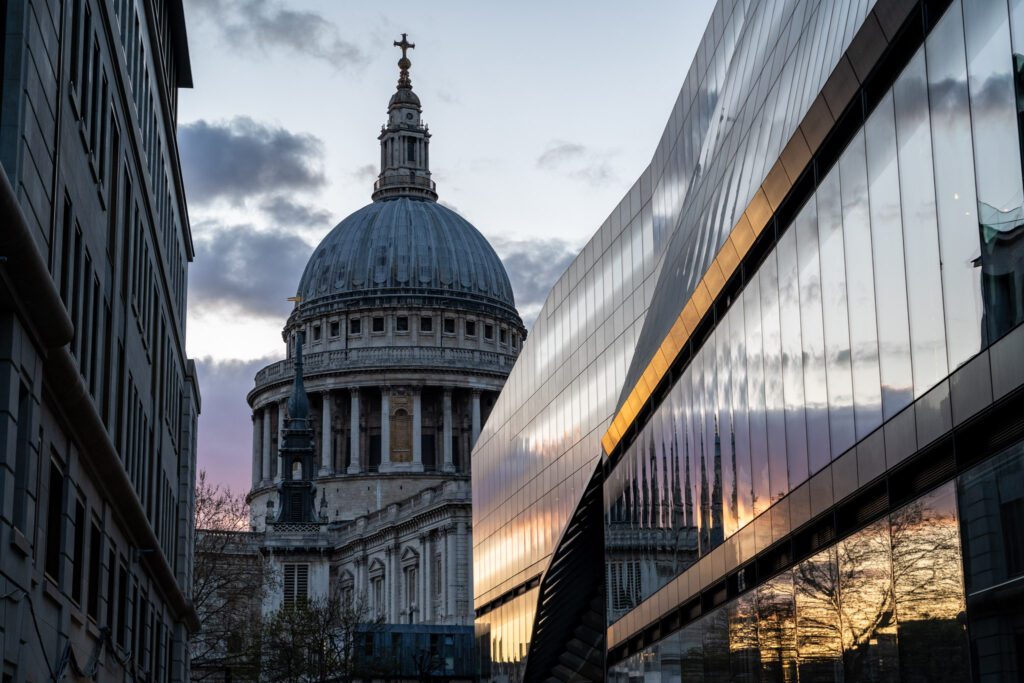
St. Paul’s Cathedral is one of the more interesting aspects of London’s history, and the archaeologist who led our excellent walking tour (we’d highly recommend it if you’re interested in the history of London – here it is) remarked that it’s probably the single most important building in all of London when it comes to the city’s history.
Why, you ask? A couple of reasons.
There are two times in London’s history that the city has essentially been leveled.
The first was in the late 17th Century, when a fire started at a bakery on “Pudding Lane” (yes, that’s actually the name of the street where all the bakeries were) and ended up burning down something like two thirds of the City of London.
Then, during the Blitz in World War 2 when a huge portion of Central London was reduced to rubble, the dome of St. Paul’s stood strong, serving as an important symbol of the resilience of the city in the face of adversity.
In both cases, St. Paul’s Cathedral played an important role in the city’s healing and coping with the disasters.
It was built after the fire as a sort of “feather in the cap” of the government at the time. We learned on the walking tour that it was very much a political symbol more than a religious one, one that said “we’re rebuilding London, and we’re doing it right.”
The truth is that German bombers could recognize the dome from above, and did their best to avoid it (though I’m not quite sure how possible that really was given the technology at the time).
We’d recommend heading up to the dome of St. Paul’s, and being the first ones up there if you can swing it. The dome access starts at 9:30 am, and it’s a long climb up a variety of different staircases to reach the top.
There are three levels on the way up – the Whispering Gallery (the interior of the dome), the Stone Gallery (the exterior of the base of the dome), and the Golden Gallery (at the tippy top of the dome).
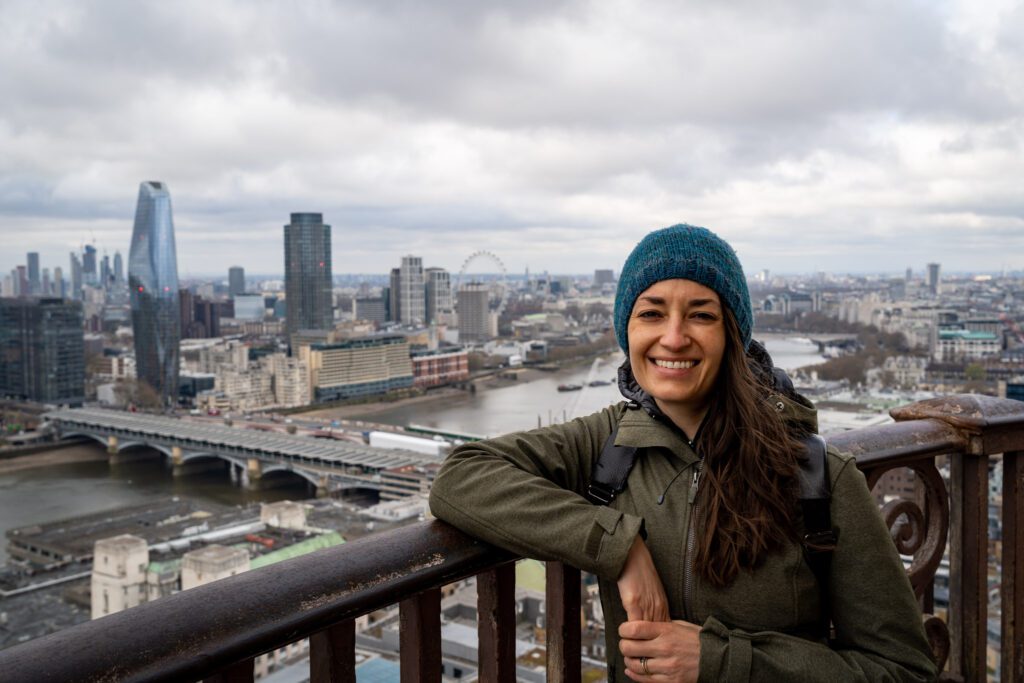
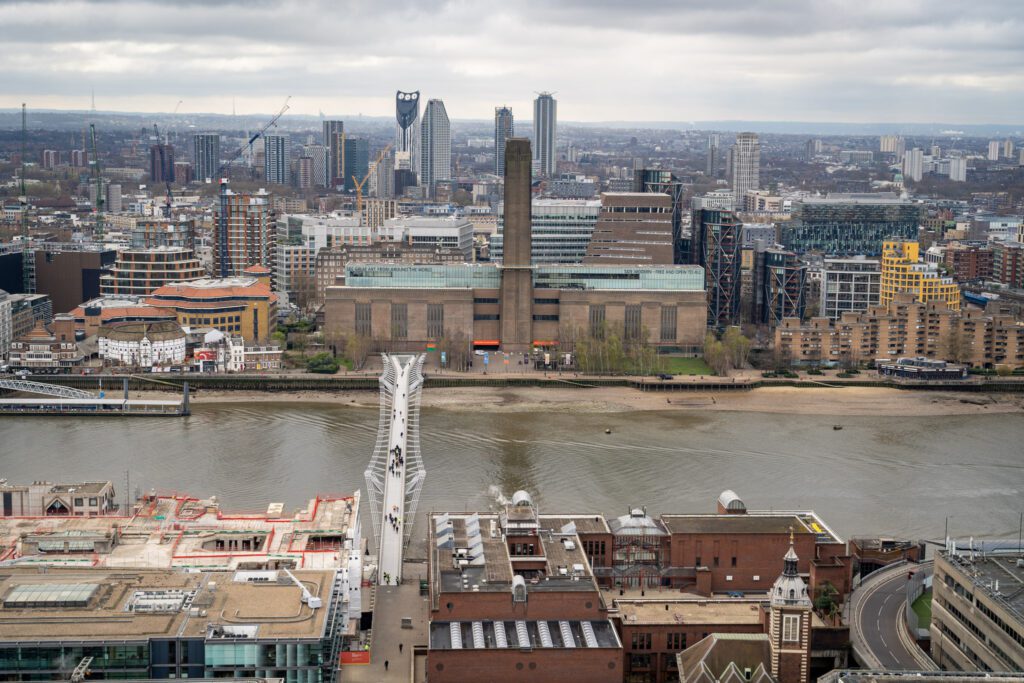
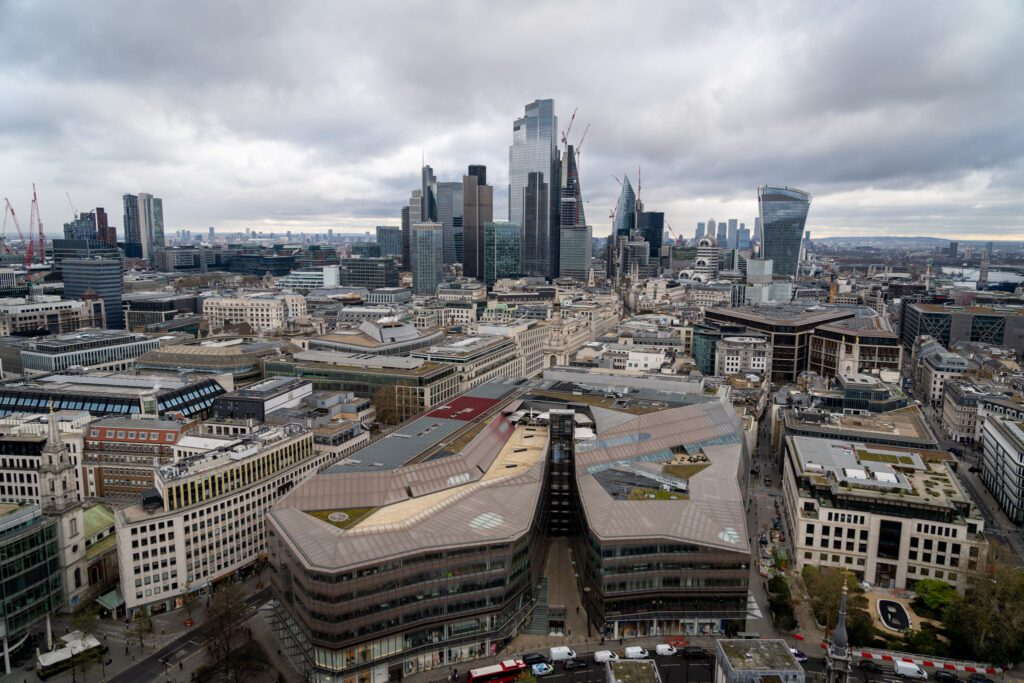
It’s worth stopping at all three, and definitely go all the way to the top, where the views are outstanding!
Make sure to visit the crypt, where two important figures in British history are buried.
You’ll find the Duke of Wellington (famous for leading British forces in the defeat of Napoleon at Waterloo) and Lord Admiral Nelson (also famous for outwitting Napoleon, among other things), among others.
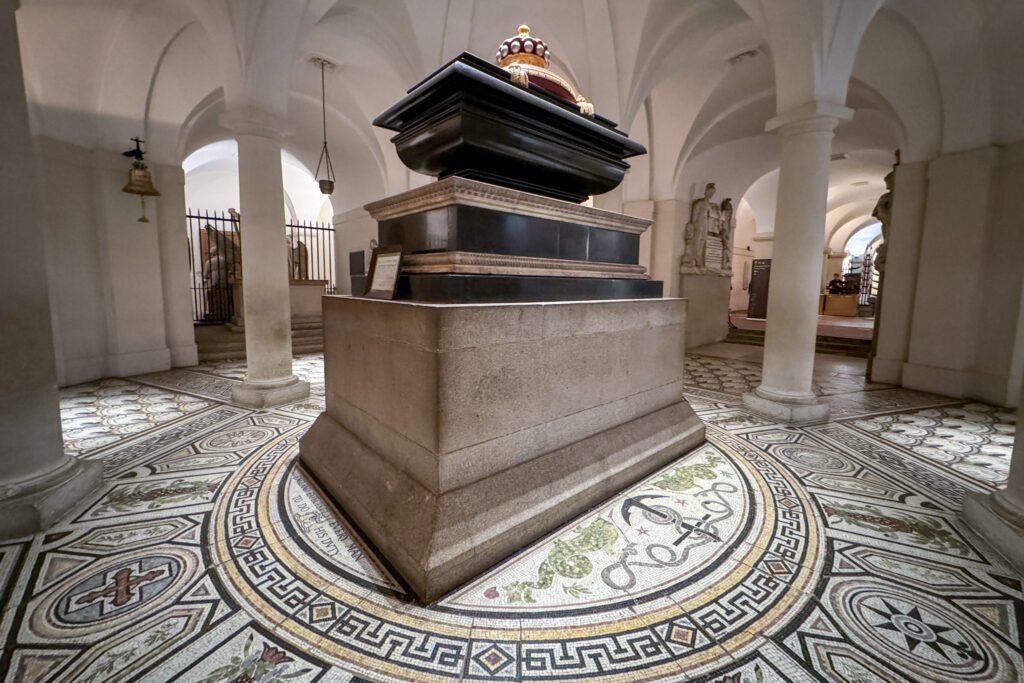
Entry is a little pricey, but we think it’s worth the money. To save money, you can book tickets online in advance for a slight discount, which saves you a few pounds a person.
More information on hours, costs, and more here. Monday to Saturday only, closed on Sundays for service.
One New Change’s Rooftop Terrace
After you’ve done the cathedral itself, head up the sixth floor free rooftop terrace of One New Change, a fancy shopping center across the street, for one of the best views of the dome in all of London.
It’s completely free, and it’s open from 6:00 am to midnight every day. You take the elevator from the middle of the building up to the terrace, and from there you have an unobstructed view of the dome of St. Paul’s.
You can find information on the terrace, including opening hours, here.
The London Museum
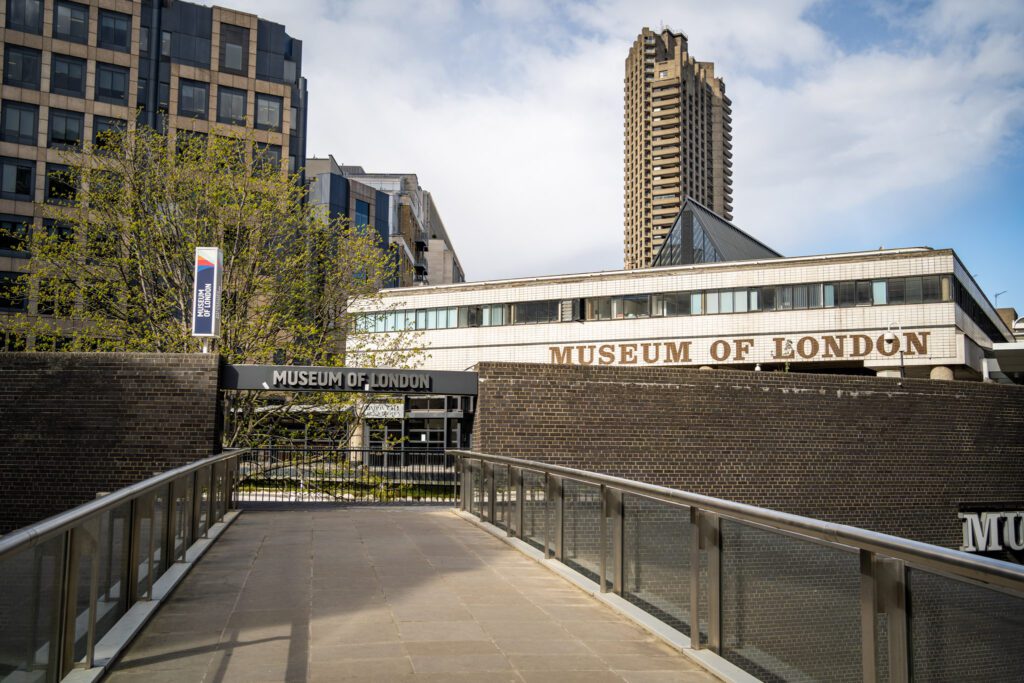
Head directly north from the cathedral up to the excellent (and free) London Museum.
It’s worth taking an hour (or two, if you’re really into it) to peruse the museum, which covers the history of the city from prehistoric times to modern times in chronological order, weaving a story about the history of London and how it came to be the city it is today.
We enjoyed this museum, and we learned a lot about British history and the history of the city that we definitely had never thought about before.
I’ll give you two examples.
First is the fact that, for large swaths of its history, London was under the control of outsiders. As Americans, we never really think of the British as being colonized and oppressed, but that is certainly how they spent the bulk of history before the medieval periods.
First it’s the Romans, then they leave and the Saxons move in, then it’s the Normans.
Second is the fact that London, the cosmopolitan city that we know and love today, was shaped by two disasters (which we already touched on above) – the fire in the 17th Century that burned the majority of the city (which at the time, was mostly wood) to the ground, and the Blitz during World War 2.
Without those two events, the modernization of London would have been much more difficult, and Central London would likely look very, very different from how it does today.
We enjoyed the museum, and think it’s a nice short way to get an understanding of the history of the city before diving into what it is today.
Important note: The museum is closed for renovations in 2025, and is set to reopen in 2026. Unfortunate because it was one of our favorite discoveries on our recent trip to London.
An Afternoon and Evening in Shoreditch
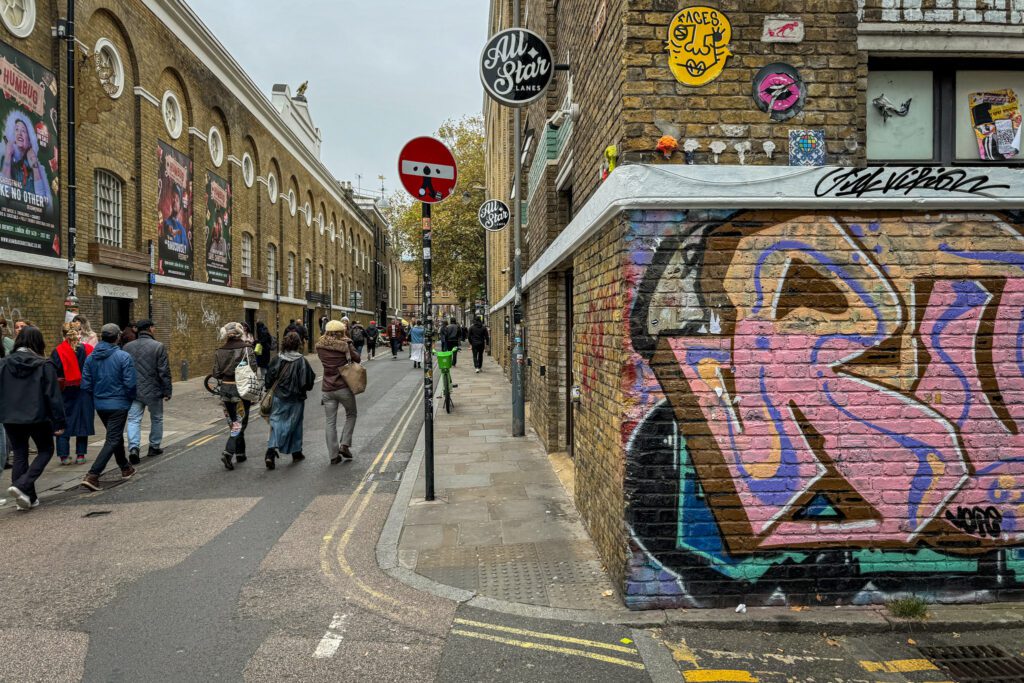
We’re not sure we’ve ever seen a higher concentration of vintage stores than we saw in Shoreditch.
And that tells you a lot about this hip neighborhood in northeast London and the transformation it has undergone in the past decade or so.
At one point, Shoreditch was completely separate from the city of London, but over the years the borders of London have continually expanded, swallowing up former suburbs on its way to becoming the city it is today.
Even the origin story of Shoreditch is a little counterculture.
It became famous because in the 16th Century, some politicians got the idea that banning playhouses (and theaters) in London sounded like a good idea. You know, to remain chaste and godly and all that.
Imagine what they’d think if they saw London today!
So, in order to meet the demand that certainly hadn’t evaporated despite the ban, new theaters were built in places like Shoreditch and Southwark, which at the time were outside of the city limits, and thus its jurisdiction.
In the 19th and early 20th Centuries, it was a legitimate rival to the West End as the center of London’s arts scene.
After the second world war, during which large swaths of the neighborhood were demolished – including a lot of housing – the reconstruction process took a little longer than other parts of London.
Since then, the story of Shoreditch is similar to many other highly gentrified areas in major cities around the world.
First the artists moved in, creating a demand for businesses that those artists liked, and finally ending with astronomical housing prices that drove out many of the original residents (and those artists, too) and brought in a more wealthy contingent, who in turn brought a different set of businesses to cater to their different needs.
On your way from the City of London to Shoreditch, there are a bunch of stops worth making, but we’re going to give you a few to start.
Start with a rooftop drink at the roof garden at the Culpeper, make your way to Old Spitalfields Market to wander the stalls with art, food, and drinks (weekends only), and then head over to Brick Lane, stopping by the Upmarket if this happens to fall on a weekend, and follow Brick Lane north into Shoreditch.
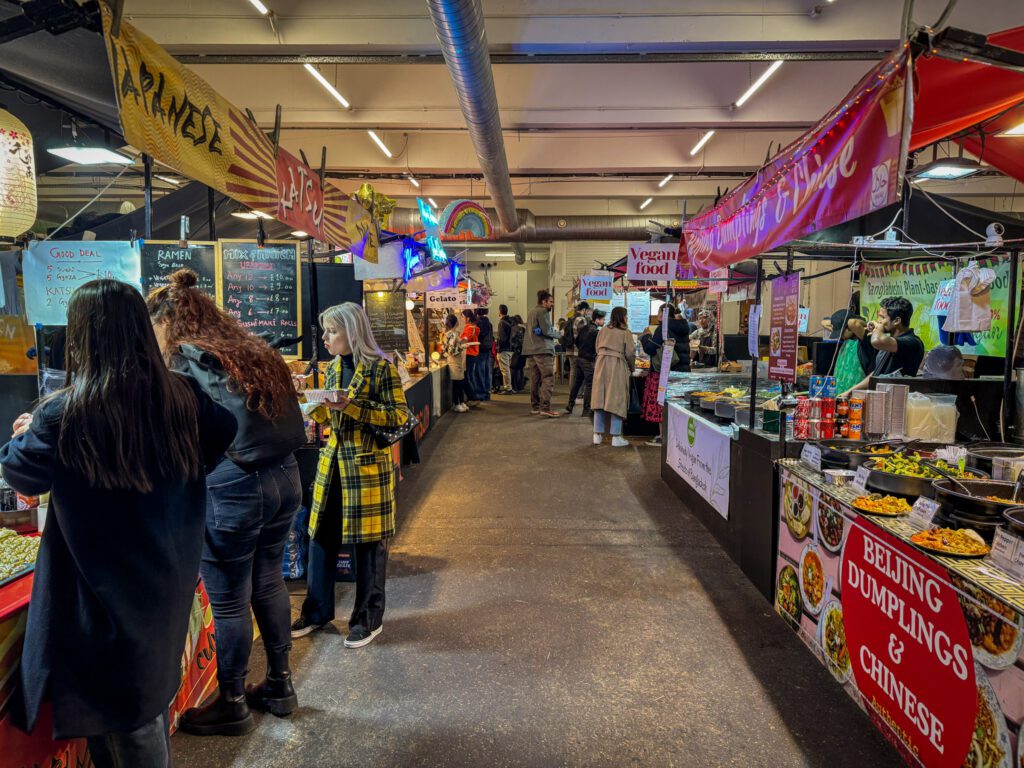
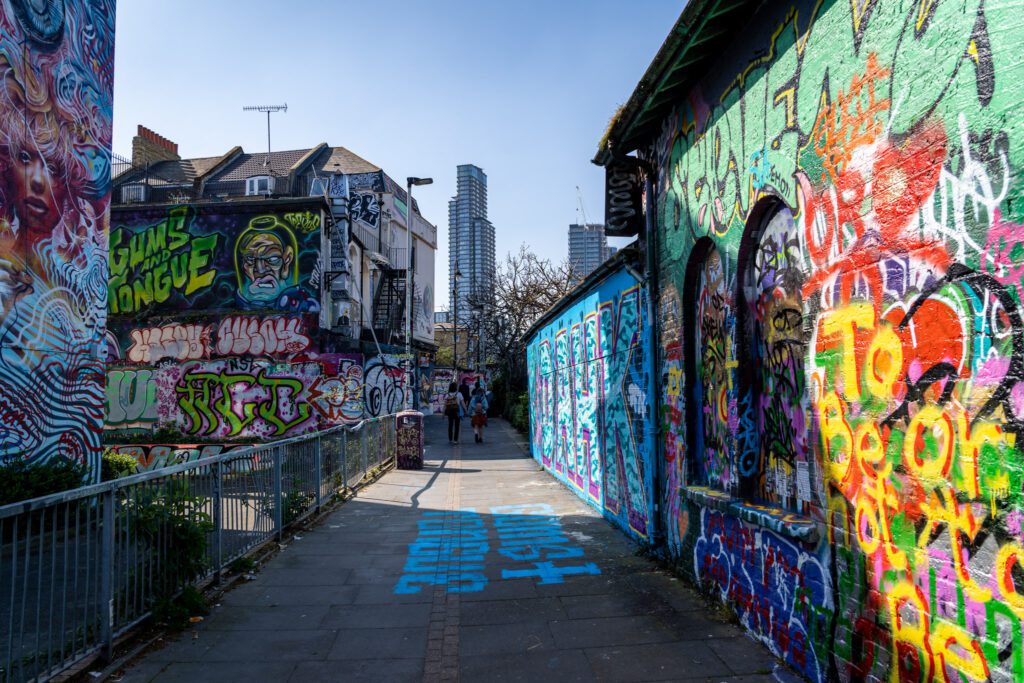
Day 2: Westminster, the West End, and a Museum
On your second day in London, start your day in the city of Westminster, make your way to Covent Garden, and head through Hyde Park to check out a museum (there are two choices here, which we’ve outlined below).
Westminster is a relatively small patch of London, but contains a higher concentration of London’s famous spots than anywhere else in the city, so we’d try to beat the crowds and head out early.
But First, Coffee!
If you’re looking for some of the best coffee in London, you’re in luck – two of our favorites are within a few blocks of each other near Westminster Abbey, which is where you’ll be starting your day today.
The first, and our overall top recommendation in London for coffee nerds (like me, Matt), is Nostos Coffee.
They have your usual drinks – lattes and Americanos and the like – but they also have an incredible special menu featuring pour over coffee and single origin espresso from some of my favorite roasters in Europe.
We came here multiple times on our latest trip because both the coffee and the service were among the best we found in London.
The second, and another of my favorites, is Formative Coffee.
Formative is more focused on espresso, and they have five or six different coffees available as espresso on any given day, with a couple of filter coffee options (batch brew) alongside them.
We not only had some really fun coffees – a white honey gesha that the owner used in the World Barista Championships and a weird green apple co-fermented coffee that was like drinking one of those caramel apple lollipops we had as kids – but the baristas went out of their way to give us advice about London (and specifically where else to go in London for great coffee).

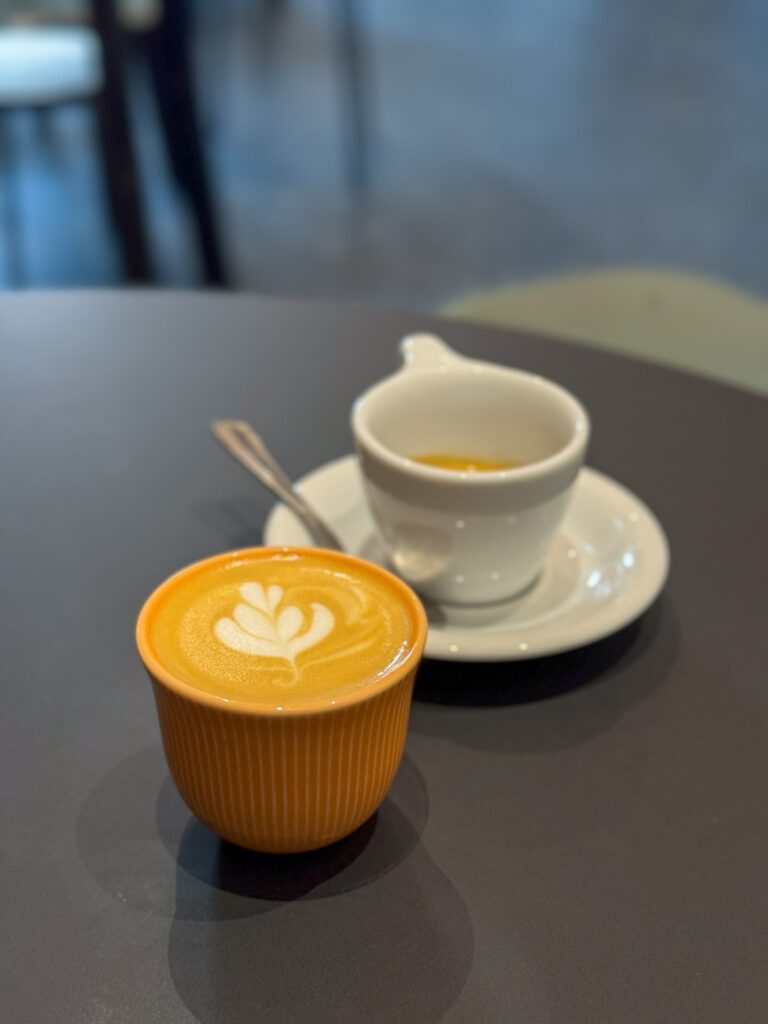
Between those two, you’ll be in great hands in terms of your morning caffeination (and ready to start your day in earnest).
Westminster Bridge and Big Ben
The first stop of the day should be the eastern end of Westminster Bridge, across the river from Big Ben (here on Google Maps).
You might be tempted to go straight to Westminster station, but we think the walk over the bridge is well worth it because of the excellent view of Big Ben you get as you cross the bridge.
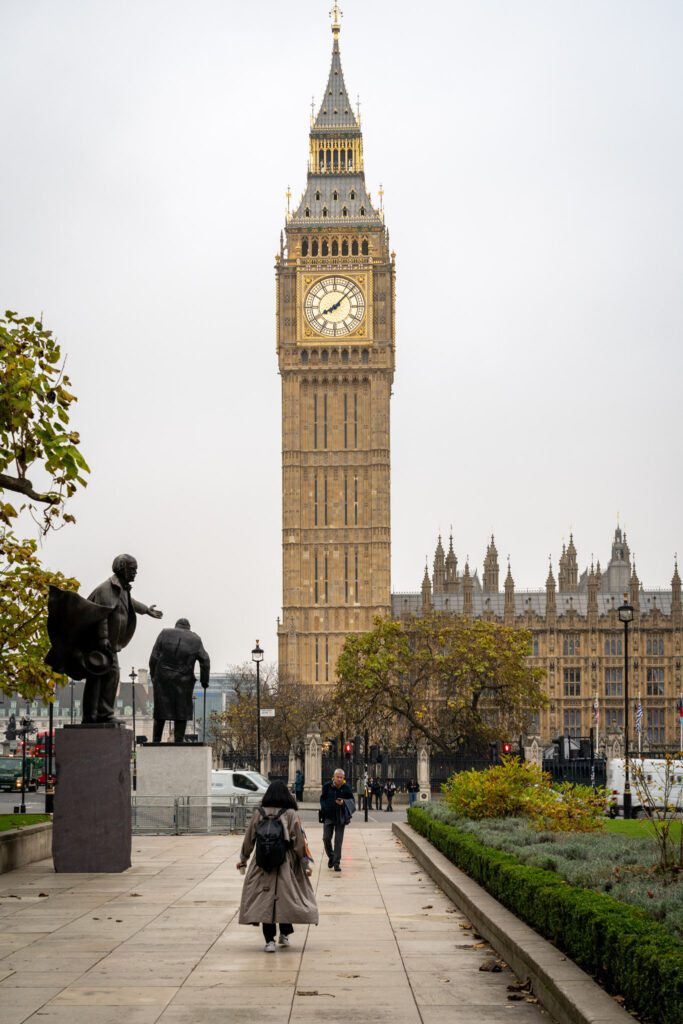
The world famous tower, officially known as the “Elizabeth Tower”, houses the giant bell affectionately known as “Big Ben”, whose unmistakable chime has sounded across the city for over 150 years.
Big Ben refers to the bell, not the tower itself.
To hear the bell going off, you’ll want to be on the bridge about 10 minutes before the turn of the hour (so, 8:50 am to hear the 9:00 am bells).
Either side of the bridge works fine, but the better view is going to be from the southern end of the bridge.
As of the time of writing, Big Ben has been under construction for several years, and there’s likely to be some scaffolding up around it. It’s still a great view, though.
At the other side of the bridge, you’ll find yourself adjacent to the Houses of Parliament.
You can actually visit the Houses of Parliament and take a guided tour that allows you to access parts of the complex you wouldn’t ordinarily be able to.
If that sounds interesting to you, you can find more information here (it’s a 90 minute tour, and it’s fairly pricey).
Westminster Abbey
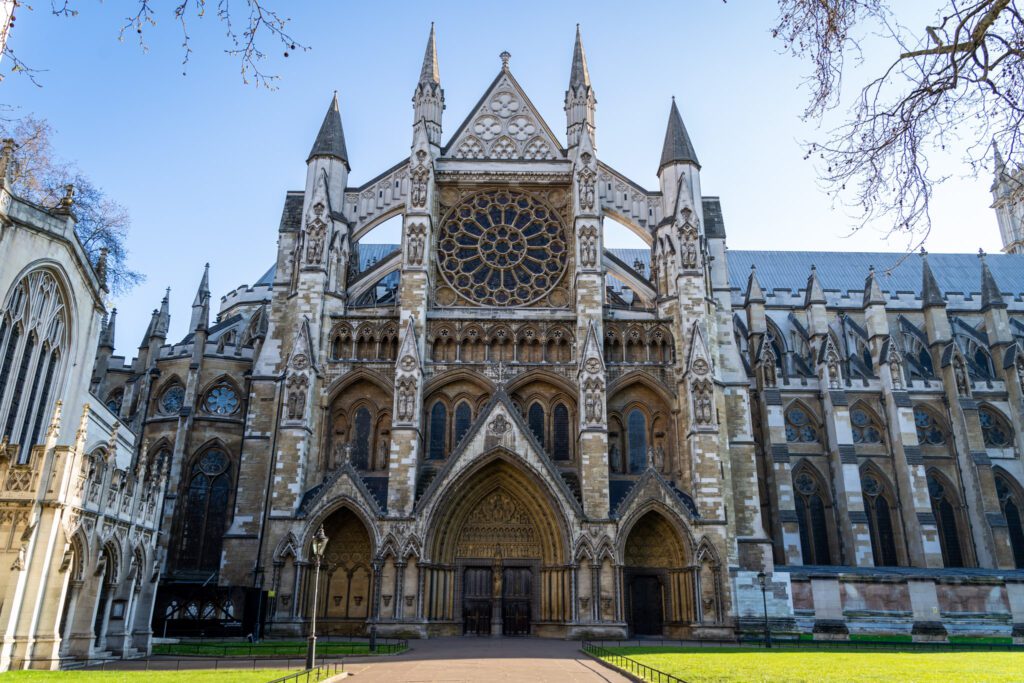
Walk across the square in front of parliament – make sure to walk by the statues of famous Brits like Winston Churchill – on your way over to Westminster Abbey, which is your first stop of the morning.
This is a gigantic Gothic Cathedral that was built in the 13th Century by Henry III as both a monument to Edward the Confessor, and as a final resting place for his own body.
The history from there is kind of fascinating, mostly because of the intermingling of the monarchy and church over the course of centuries.
On a walking tour, the history professor leading the tour (we did this walking tour and really enjoyed it) said that, essentially, the church was very, very rich, and the monarchy said something to the effect of “yeah, we want in on that.”
Which I’m sure is painting with broad strokes and missing a lot of historical nuance.
But on the other hand, yeah, that checks out.
Essentially, in the mid 15th Century, Henry VIII (yes, that one, the one that enjoyed beheading his wives) got mad at the Catholic Church for not signing off on his divorce.
So, naturally, he seized all assets owned by the church and took control of them for himself. Often, selling off pieces of them to fund his various adventures around Europe.
From there, the royal family and the church became intertwined. Divine right and all that jazz.
Today, it’s the site of royal weddings, coronation ceremonies, and burials, but it’s mostly a tourist attraction.
More than 3,000 Brits are buried in Westminster Abbey – the most famous being many of the royals of the last few centuries, and people like Sir Isaac Newton and Charles Darwin.
Make sure to look down as you walk around the interior – it seems like every step you take inside of the Abbey, you’re walking onto a new burial site with the name and dates of their life/death.
The Abbey opens at 9:30 am (9:00 am on Saturdays, closed on Sundays), which is pretty early, and we’d recommend trying to be one of the first people in the door.
To do that, we’d buy online tickets in advance, which go on sale two months in advance.
Buckingham Palace (and the Changing of the Guard)
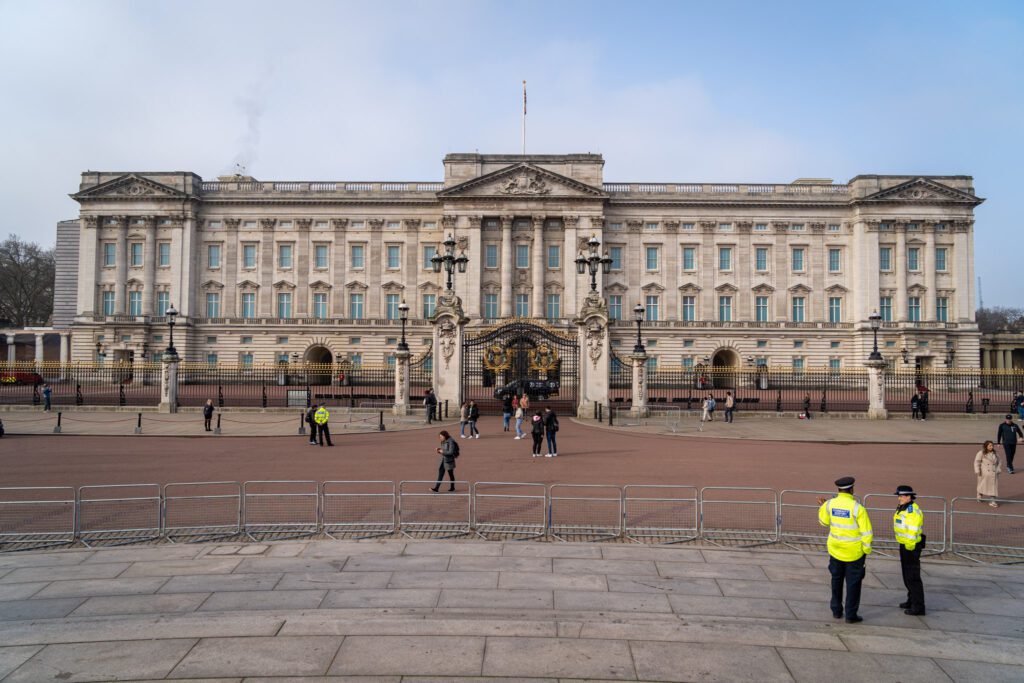
From Westminster Abbey, it’s a nice walk through St. James’s Park to get to Buckingham Palace, which is where the King supposedly lives (but spends almost zero time there these days, according to multiple people we talked to).
Side note: What the heck is going on with that “s’s” at the end of “St. James’s Park”? Yes, that’s the correct spelling. We had to quadruple check.
This is also where the most “touristy” activity on this entire itinerary happens – the Changing of the Guard.
That being said, it’s quite the spectacle (we can’t believe this still happens, to be completely honest) and it’s worth seeing once, as long as you’re prepared for the crowds and have the flexibility to show up a little early at a specific time on a specific day.
You’ll need to pay close attention to the official schedule for this one, as the ceremony schedule varies by the season.
You’ll also need to plan your day to arrive here by at least 10:45 am, and probably a lot earlier if you want to get a good view, especially during the summer.
Trafalgar Square and the West End
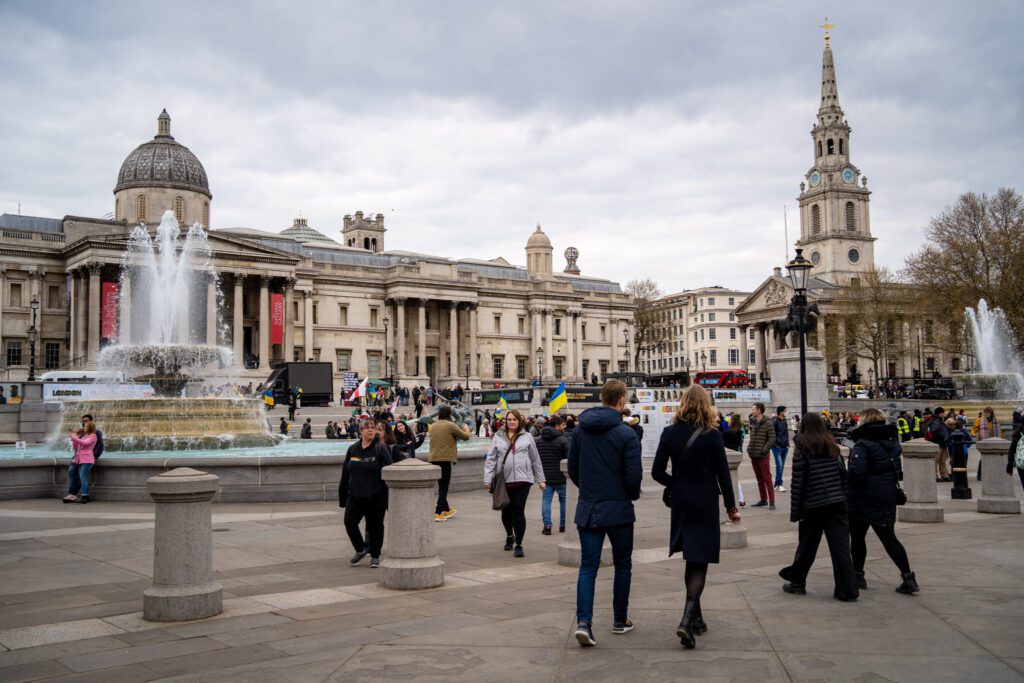
At some point during their London visit, virtually everyone ends up at Trafalgar Square. Probably because it’s right in the middle of all the action.
To get there from the palace, just walk straight out “the Mall” and you’ll land at the southern end of the square after you walk under the Admiralty Arch.
The square is home to Nelson’s Column, dedicated to the beloved naval hero of the same name who outwitted Napoleon multiple times, Trafalgar Square has been a huge draw for tourists, locals, and flocks of pigeons since Victorian times.
There’s also an excellent view back towards Big Ben from the south end of the square. And lots of lions.
What is it about lions that makes every single king or queen go “what animal do I want to be? Yeah, a lion, that’s the one!”
Why not switch it up and get creative every once in a while and be a warthog or a water buffalo or something?
Seven Dials Market for Lunch and Exploring Covent Garden
Another food market! Hooray!
Seriously though, our favorite part of London was all the incredible food markets, which is pretty evident in our construction of this itinerary. There’s basically a different food market every single day!
Today, it’s the Seven Dials Market, a food hall housed in a former warehouse in Covent Garden.
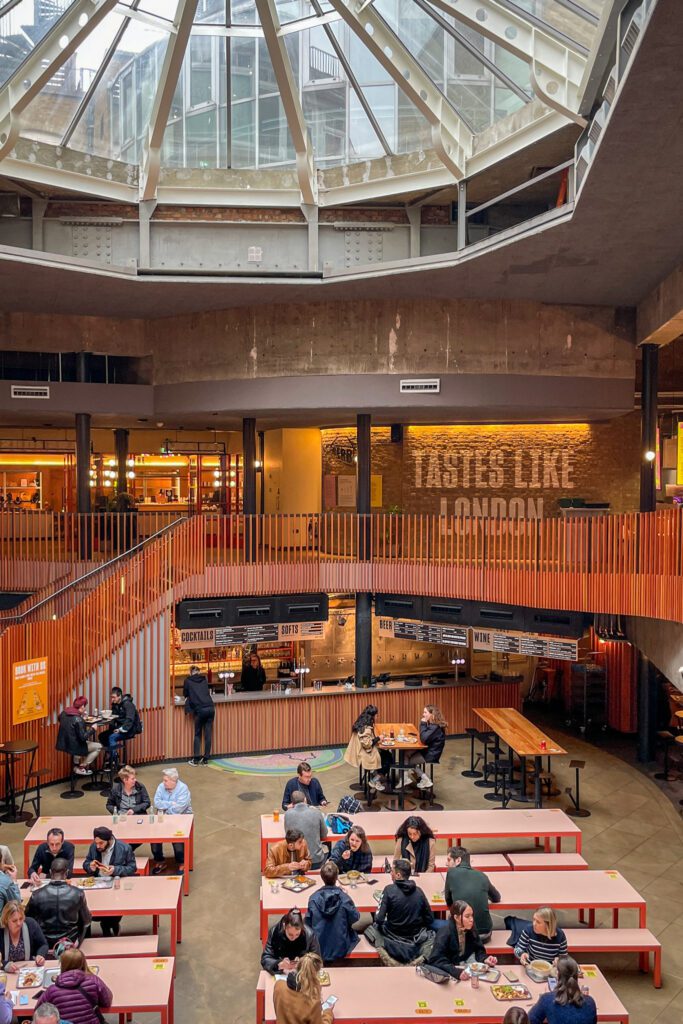
We were confused by the banana logo that we saw all over the building, and it turns out this warehouse was primarily used to store bananas back in the day, hence the logo. And cucumbers, too!
There are a ton of good food options here, and we have one specific recommendation, Chai Guys, which is some of the best chai that Alysha had in London (she LOVES chai, and these guys / gals do it right!). Get the kadak, which is a sweeter, creamier version.
The area around the market is also worth exploring.
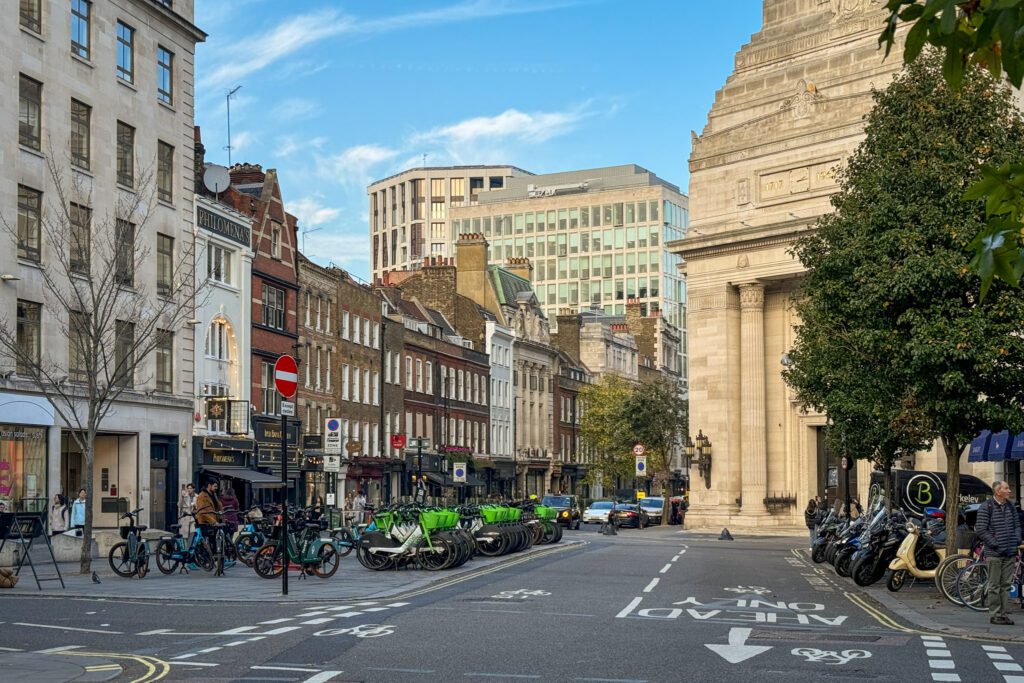
Historic and elegant Covent Garden, situated in London’s West End, is probably our favorite part of central London.
But Covent Garden was absolutely not always the manicured, tourist-friendly district that you find today.
In fact, we learned on our tour of the National Portrait Gallery (more on that in a second) that it was basically the Red Light District for most of its history, and it’s only a recent development that it has become relatively posh.
It’s worth a stop at the Apple Market to see it at its poshest, where you’ll find a bunch of luxury stores inside a historic produce market.
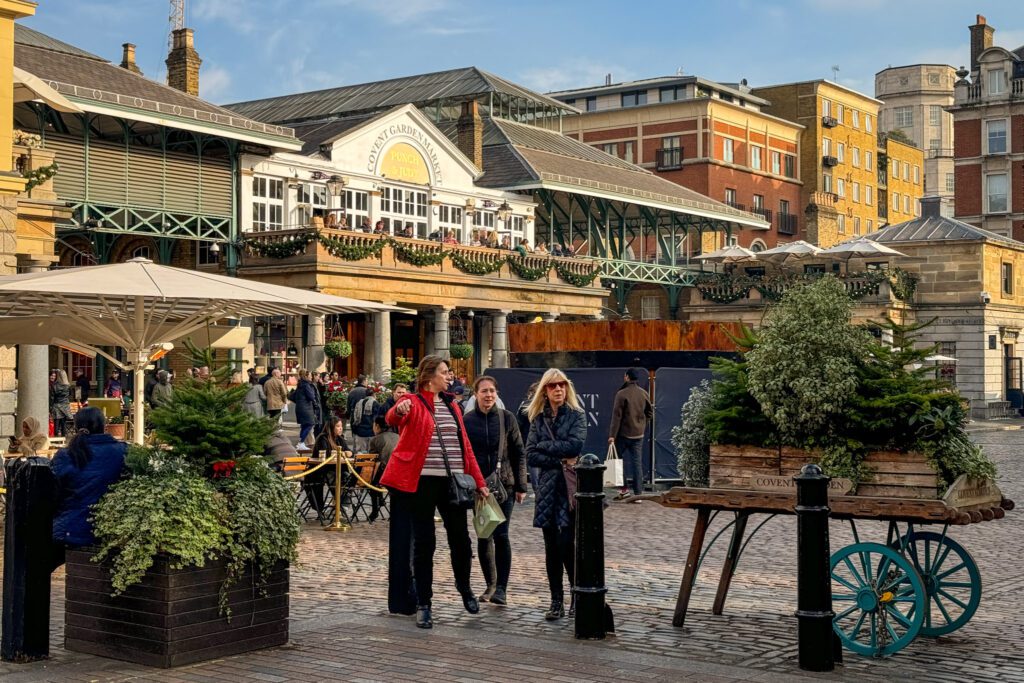
If you’re interested in a crash course in Covent Garden history, we’d recommend this walking tour with the company who we did our National Portrait Gallery tour with. I wanted to do this on my latest trip, but the timing didn’t work out to make it happen.
There’s enough to do in Covent Garden to last an entire day, but you’ve got a lot to see, so we’d say that you should get some food, do some wandering around the Seven Dials and Neal’s Yard areas, and move on.
There’s some good shopping, some great coffee (Monmouth, in particular), and we enjoyed Neal’s Yard Dairy, where we picked out a couple of English cheeses to enjoy later with some excellent fig jam.
Choose Your Own Museum Adventure
We love the fact that most of London’s museums are completely free, which is something we’d love to see happen at home more often because it makes it so much more accessible – you don’t have to wander around for seven hours trying to make the most of the $40 you spent on admission, you can just see what you want to see and leave.
However, you should know going in that it does mean that these museums are going to be CROWDED at peak hours (think the middle of the day).
You can and should make a reservation to visit if you can.
A couple of notes here before we get to the two museums we would recommend focusing on.
We’re going to focus on museums that say something meaningful about the history of London and the U.K. more broadly, which means the National Gallery and Natural History Museum are out. Both could very well be in any major city around the world.
We also would absolutely NOT recommend the Churchill War Rooms, which are not free (and are relatively expensive) and absolutely made their way onto my “the most overrated tourist attractions in the world” list.
It’s just one big propaganda campaign about how great of a guy Winston Churchill was (spoiler: he, uh, wasn’t) without any nuance or acknowledgment of his flaws.
He was definitely a war hero, but that didn’t come without any downsides.
If you’re really interested in the World War 2 stuff, we’d highly recommend heading to the Imperial War Museums across the river, which is both free and offers a much more balanced look at the war (plus an exhibit on the First World War, too).
Which means there are two museums – both near Covent Garden – that we think would make a good stop for your afternoon; the National Portrait Gallery, and the British Museum.
Option 1: The British Museum
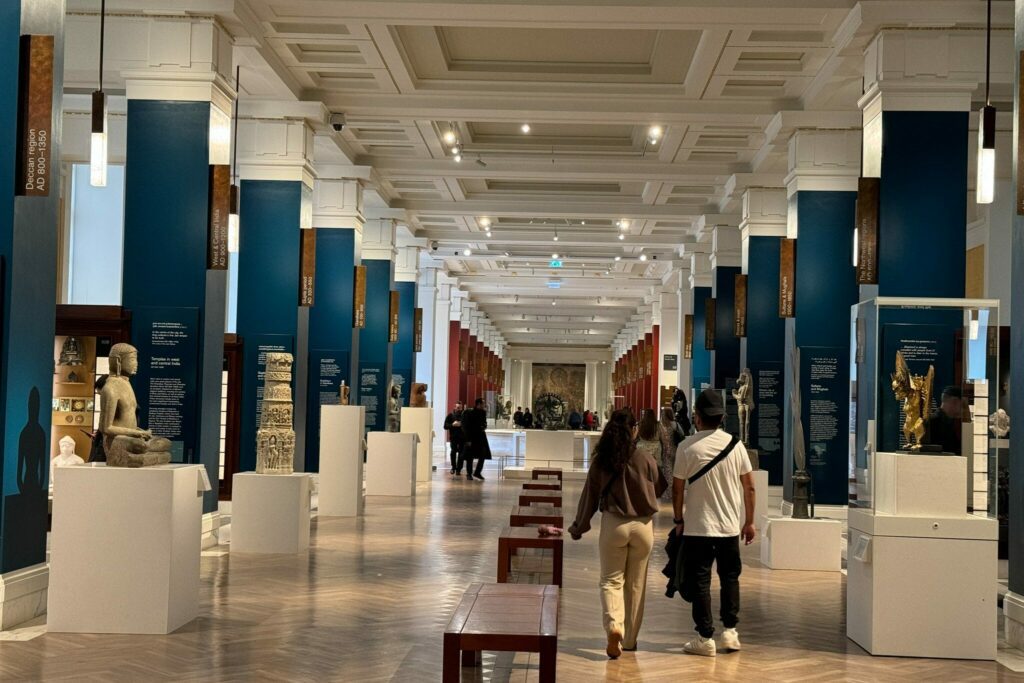
We actually went to the British Museum on our previous trip to London, and left within 30 minutes or so.
For two reasons.
First, it’s not a particularly well thought out museum – how could it be with so many different time periods and culture covered – and it’s kind of all over the place.
We didn’t know where to start, so we started with the Egyptian artifacts, which leads me to the second reason.
Second, this is all stolen stuff.
Imagine this for a second: you walk into a museum in Egypt and find the remains of the British Royal Family on display for the world to see. Do we think that would go over well?
We don’t, and the cultural voyeurism felt a little strange to us.
However, like I alluded to above, the British Museum DOES tell an important story about the history of the U.K., London, and the British Empire, so I was determined to find a way to see it in a mindful way.
After a bunch of research into different tours, I stumbled across this guided tour with Daniel that I immediately fell in love with (and booked) because it tackles the issues with the British Museum head on.
It was a great way to go through the museum, and felt more like a conversation than a lecture. We talked about the artifacts we were looking at, their significance to the culture they actually belong to, and how they ended up in the Museum’s collection.
We also learned about all of the controversy around giving things back (spoiler: they can’t and won’t for various reasons).
All that being said, there really are some cultural treasures from India, China, and Egypt in this museum, along with a tiny collection of things from the British Isles (which is kind of funny – usually you’d expect that section to be bigger).
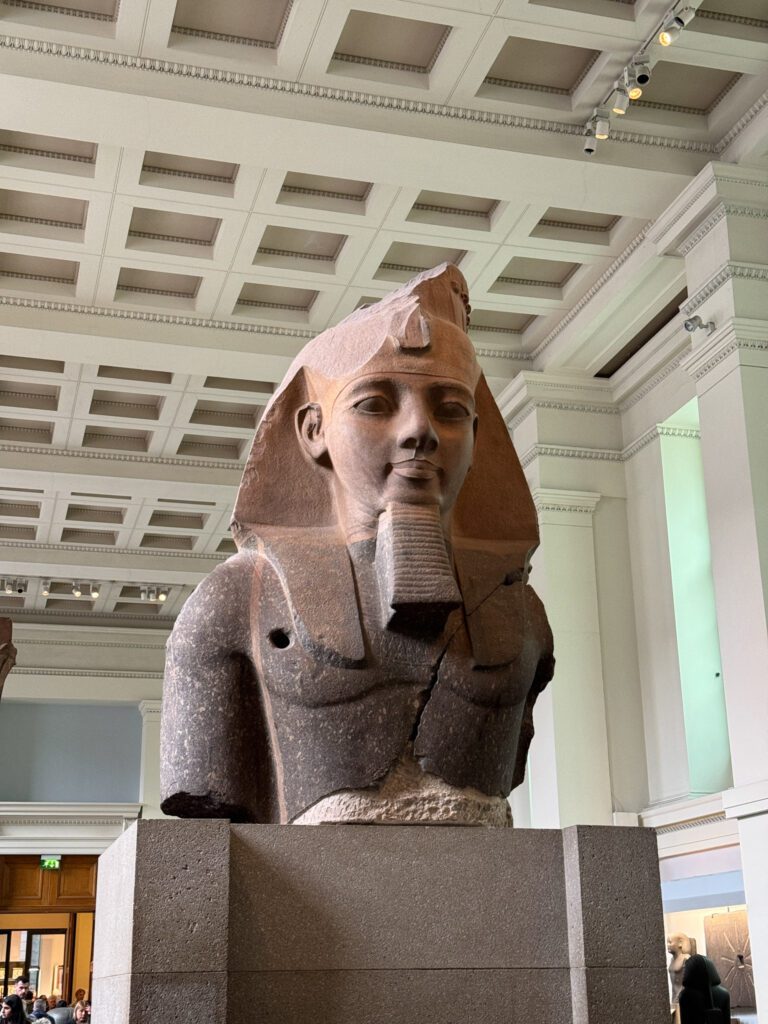
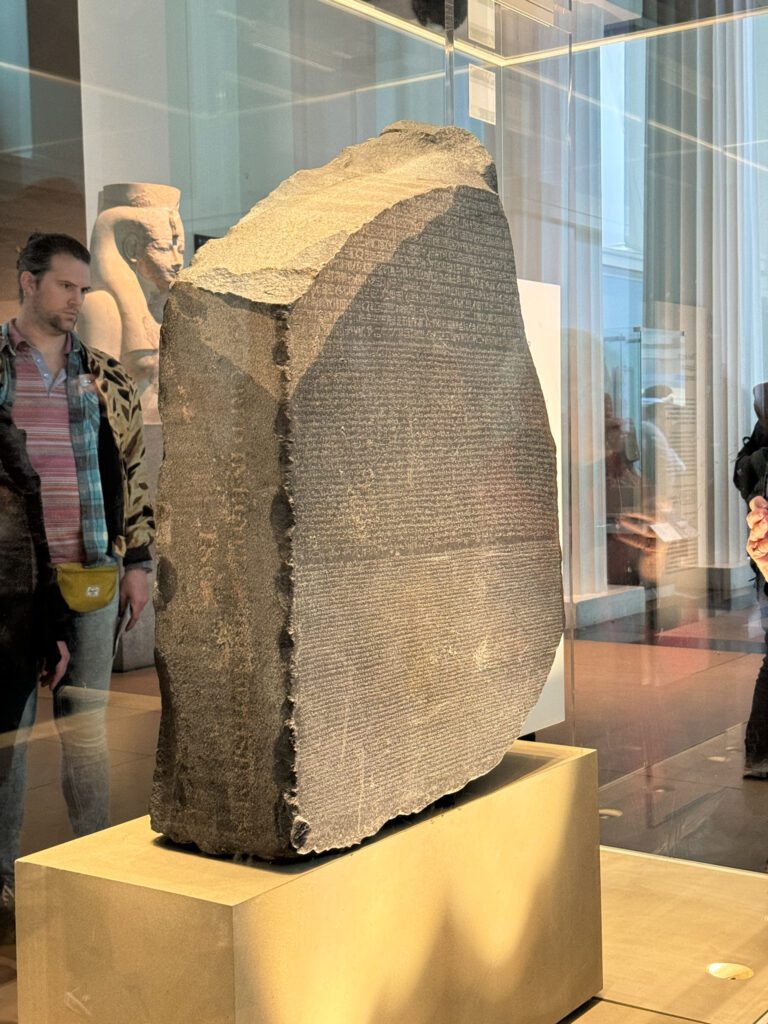
It just comes with a bunch of complicated questions and concerns that are hard to process without an expert helping you work through them.
And we think thinking about those complications is an important part of visiting this museum.
The museum itself is free, though lines can get extremely long (which is the security line) at peak hours. Leave the bags at home and head to the back entrance (here on Google Maps) to skip that line BUT you can only do that if you do not have bags.
Option 2: The National Portrait Gallery
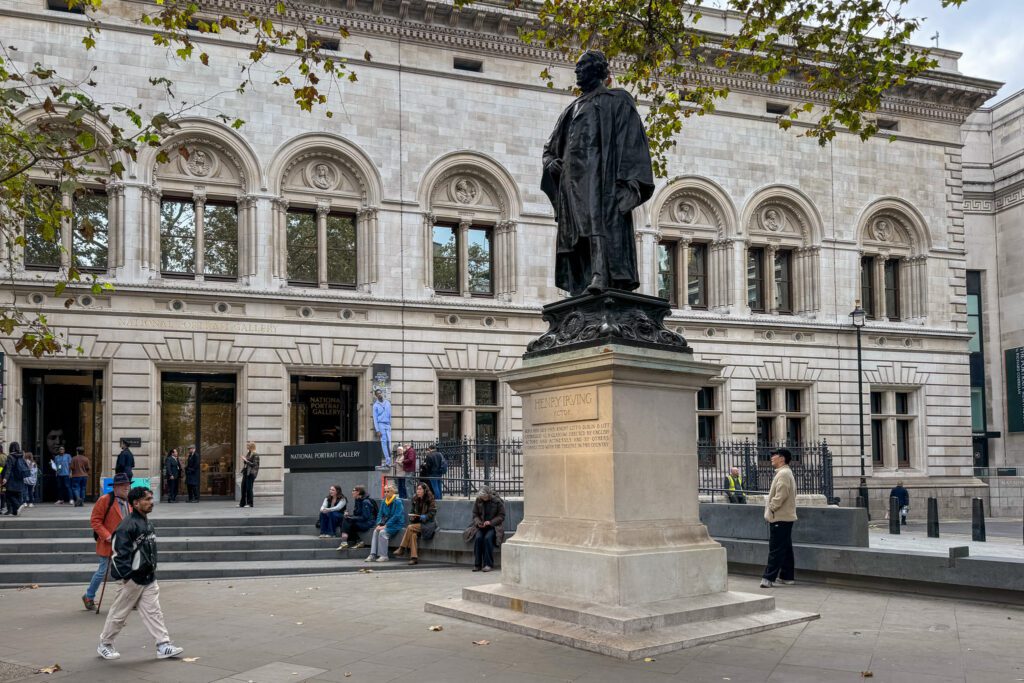
Not to be confused with the National Gallery, which is kind of just a run-of-the-mill art museum, the National Portrait Gallery is a collection of, you guessed it, portraits of various mediums and time periods that tell a story about the country’s history.
Portraits ranging from regal interpretations of George the III (of Hamilton fame) to various abolitionists and suffragettes (and everything in between) adorn the walls, and there’s not really a clear narrative, which makes it a little hard to wrap your head around.
On this last trip, we opted to do a guided tour here (with aforementioned Rebel Tours) and really enjoyed it.
We spent a couple of hours getting a crash course in British history, with a mix of the mainstream history featuring kings and queens, and some lesser known but equally important figures like the suffragettes and abolitionists who shaped the United Kingdom as we know it today.
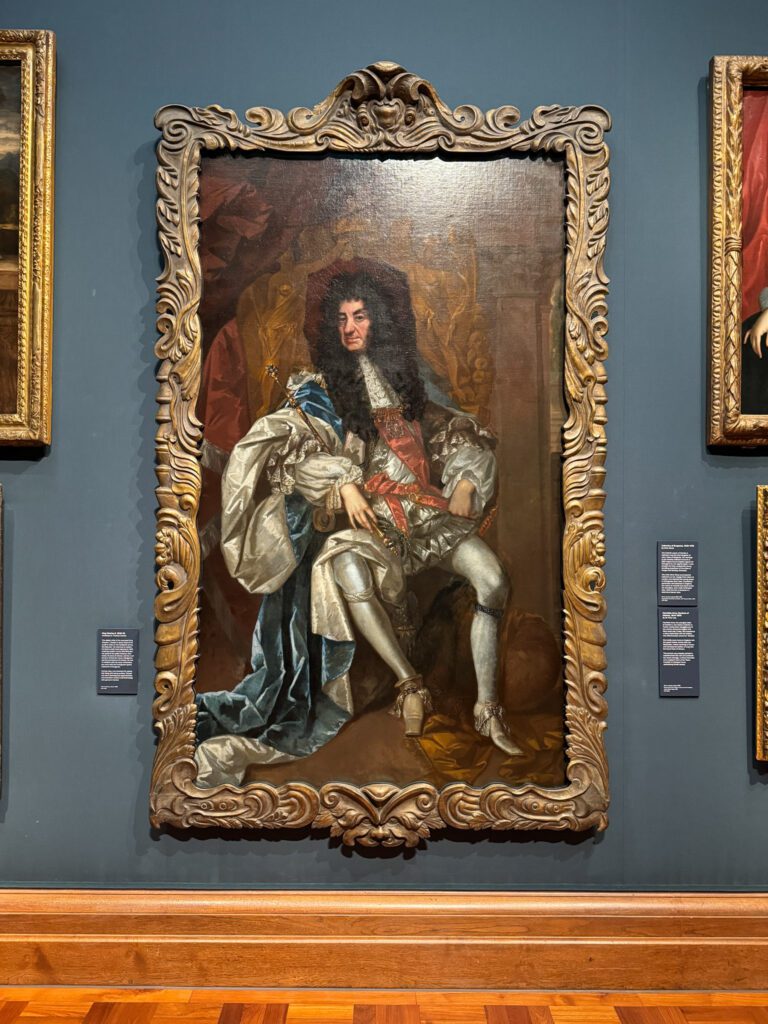
They also have free tours of the gallery at 12:00pm and 3:00 pm (at the time of writing) that cover the highlights in 45 minutes.
Our last recommendation if you don’t do the tour we recommended above is to bring your own headphones so that you can take advantage of the digital guide, which you’ll use on your own phone.
Visiting the museum is free, but it is recommended that you make a free online booking in advance of showing up.
The gallery is also open late on Fridays and Saturdays, which would be a nice relatively quiet time to enjoy the museum.
Wandering Hyde Park
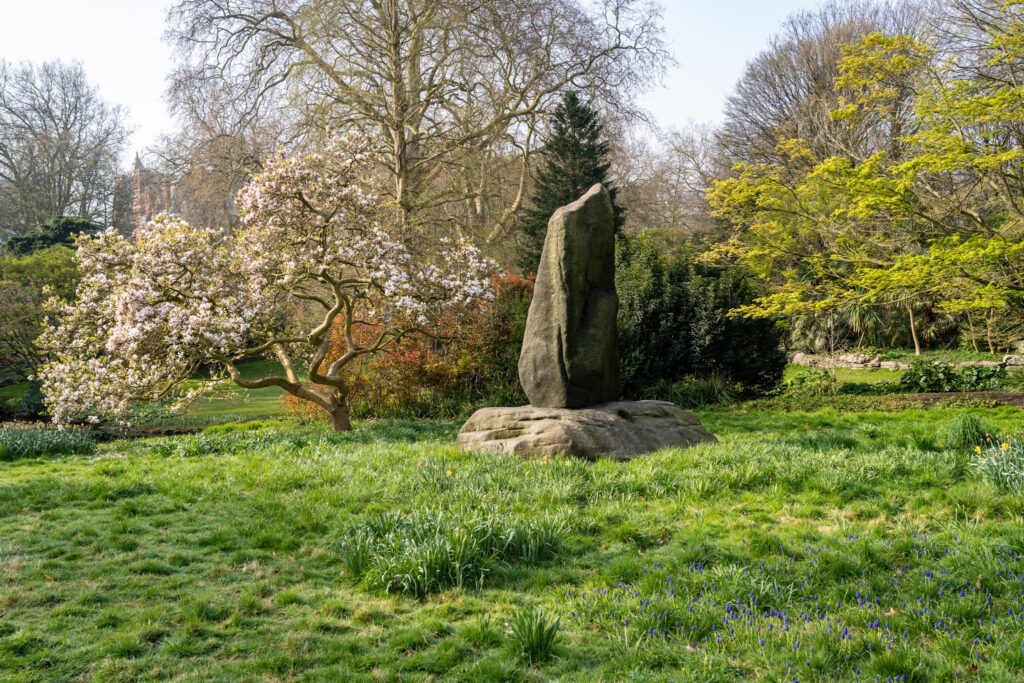
After a history lesson, it’s time to get outside and get some fresh air. Make your way towards the southeastern corner of Hyde Park.
To get there, you can either walk down Oxford Street through Soho, which is similar to Times Square in New York or the Champs-Élysées in Paris, or you can hop on the Tube (Piccadilly Line) and get off at Hyde Park Corner station, which is at the southeastern corner of the park.
We’d recommend starting at that corner of the park because you get to see the Wellington Arch, which commemorates the Duke of Wellington’s defeat of Napoleon.
Side note: Everybody has a victory arch – the Arc de Triomphe in Paris, the Brandenburg Gate in Berlin, the many victory arches in Rome around the Forum, everybody gets an arch!
Then, as you enter the park, you’re immediately confronted with the rose garden, which is cool (although it won’t be blooming in the winter and fall).
Spend some time wandering through the park, checking out the Serpentine (that’s the lake) and the Serpentine Waterfall (here on Google Maps), a particularly pretty section of greenery.
Day 3: Southbank and the Tower of London
On your third day, start off bright and early at the Tower of London, then make your way across the Tower Bridge to start a walk along the south bank of the Thames down to Westminster Bridge, with plenty of stops along the way (including a stop at Borough Market for lunch).
Important itinerary note: Since Borough Market is closed Sundays, we’d make sure this day lands on any day but Sunday. Ideally a weekday, because Borough Market is wild on Saturdays (many friends in London told me not to go on a weekend).
The Tower of London
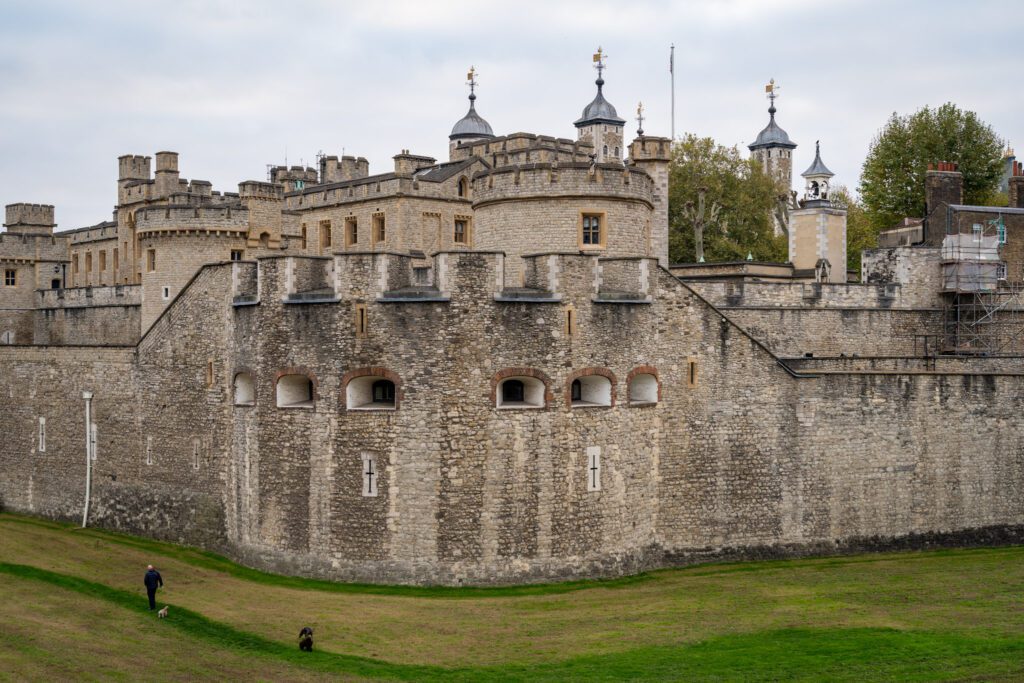
On my latest trip to London, I spent my first morning solo awaiting the arrival of my brother, and I decided to tackle the Tower of London that morning so that I had something to do while I was jet lagged and tired.
At that point, I had already done the Tower of London twice before – never on a tour – and I realized as I was walking through the room displaying the Crown Jewels that I actually had no recollection of ever seeing them before, despite having done it twice.
That’s probably because we spent only about an hour on each visit, which isn’t really enough time to understand what you’re looking at.
On this last trip, I decided to do this guided tour at opening – which includes the Ceremony of the Keys where the Yeoman Warders unlock the Tower for the day – to spend a little more time understanding what exactly I was looking at, and I enjoyed it and it definitely gave me a deeper understanding of the significance.
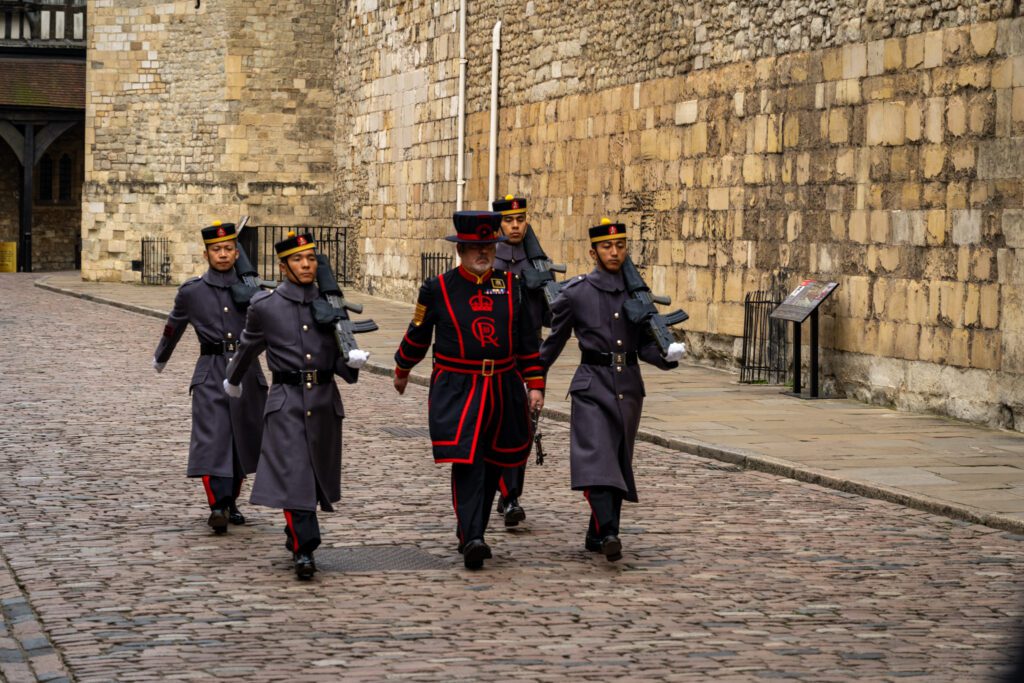
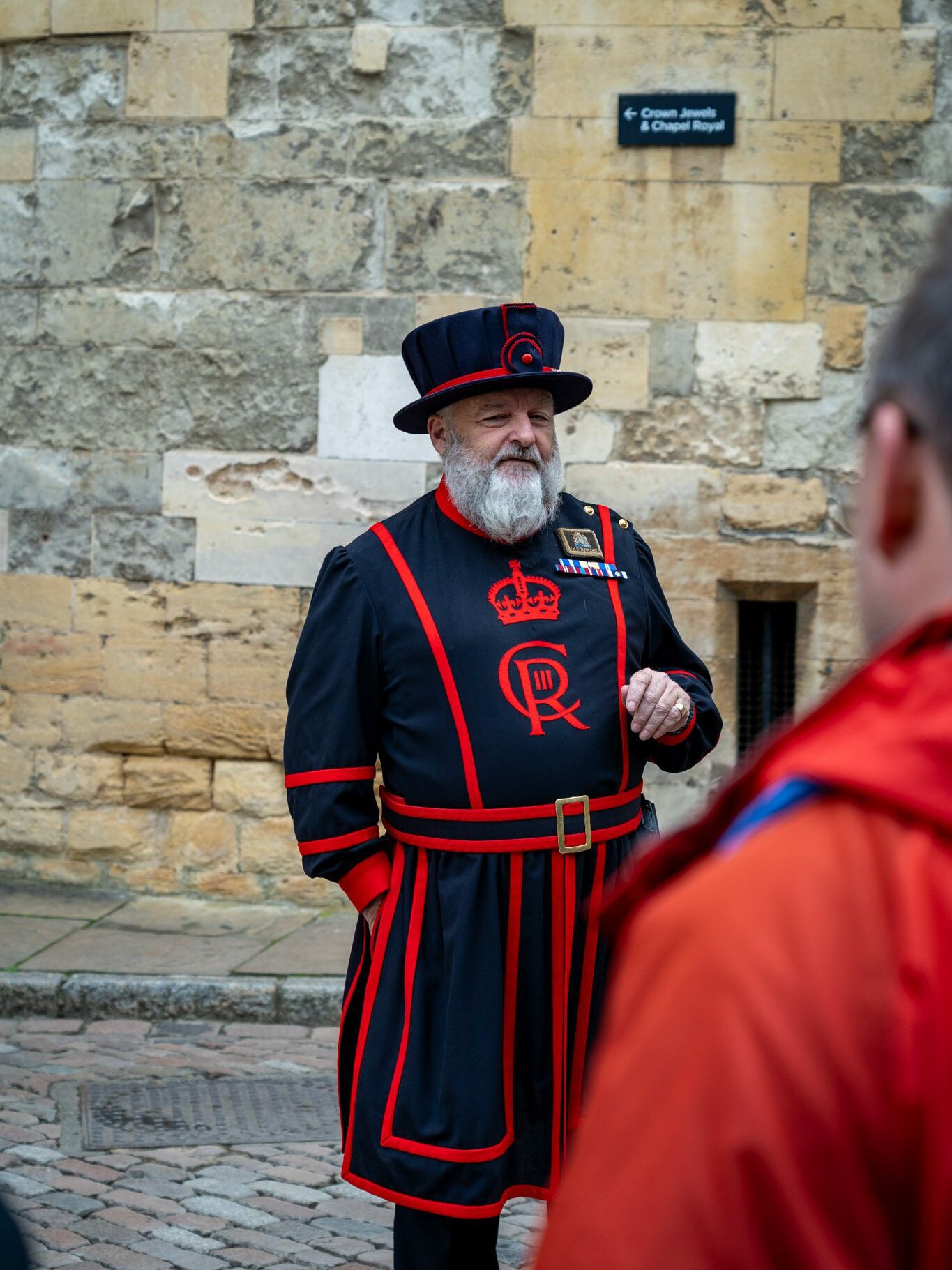
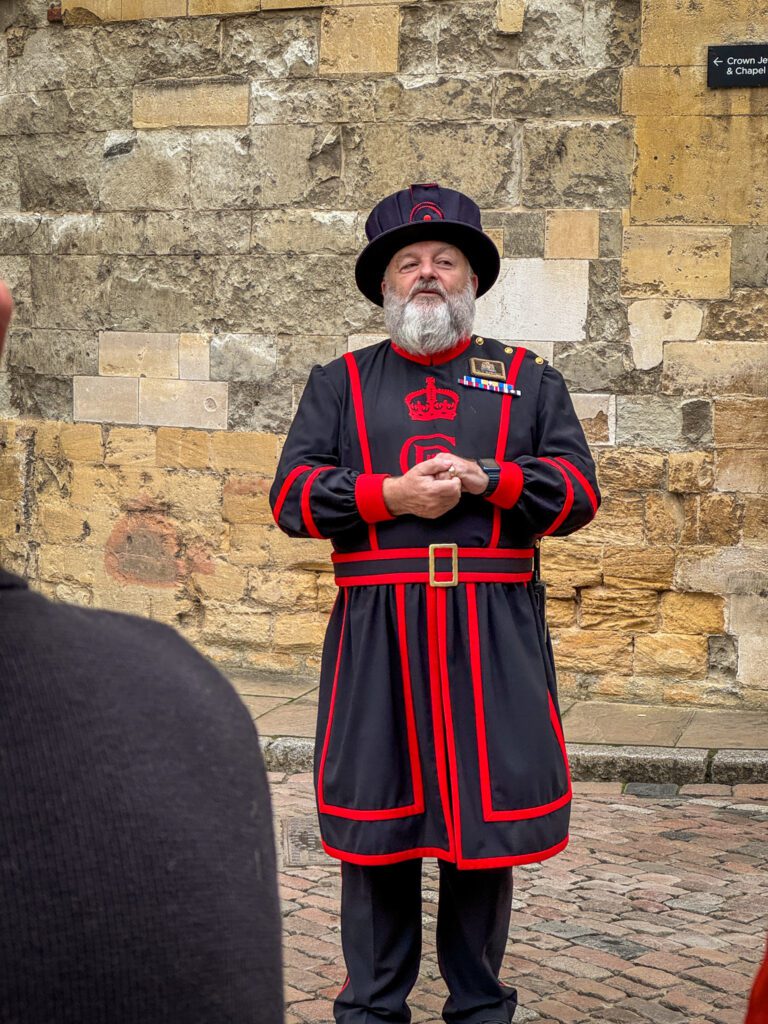
It also meant that we were literally third in line to enter the building where the Crown Jewels are held, which was cool.
Apparently in peak times there are LONG lines to get into that building, but we basically had it to ourselves.
Whether you do the tour or not, we’d highly, HIGHLY recommend visiting the Tower of London first thing in the morning.
And we’d go a step further and say your first stop should be the Crown Jewels.
It’s a popular tourist attraction, and we were totally expecting it to be crowded early on a weekend morning when we showed up.
But, somehow, when the doors opened, it was miraculously empty, save for a few other groups.
Get there at opening time if you can. You’ll have the place largely to yourself, and it will get more and more crowded over the morning.
Anyway, what is the Tower?
The Tower of London sits at the southeastern corner of the town of Londinium, which was established by the Romans.
The tower as we know it today was built in the 11th Century by William the Conqueror as a fortress, and has served a wide variety of purposes since its construction, including as a royal palace and, probably most famously, as a notorious prison.
When you really get into it, the history of the Tower of London is pretty dark.
There were so many people executed and tortured here that there are more than three different areas that are marked as places of execution in and around the tower.
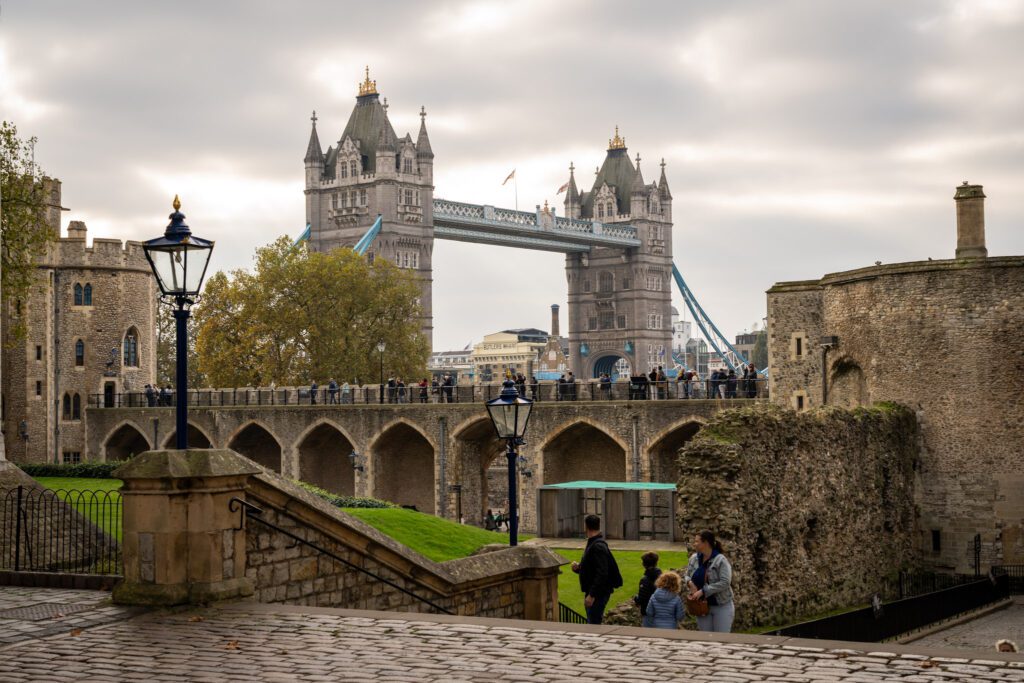
Mostly, it was political opponents who were executed for trumped up crimes to get them out of the picture.
Multiple members of the royal family have also died within the walls of the Tower, including Henry VI and a pair of princes who disappeared (and were later confirmed to have been buried in the tower).
Since its construction, it has been constantly added to and expanded.
Today, the main attractions you’re going to focus on are the Crown Jewels, the ramparts, and the White Tower – the big castle-looking structure in the middle of the complex.
If you’re looking for a different tour, we’d highly recommend joining one of the Yeoman Warder tours, which happen every 30 minutes and are included in the price of entry.
More information, including prices and current hours, is available here.
Tower Bridge
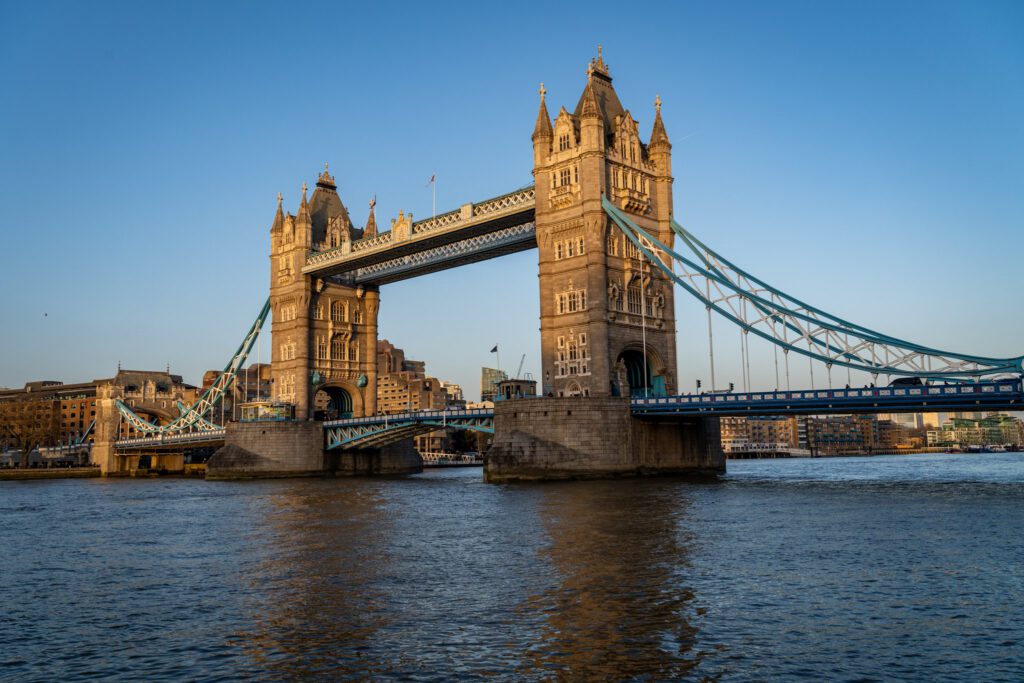
To get to your next destination – the south bank of the Thames – you’ll need to cross the river. You have two options here, and both have their advantages.
We’d recommend crossing over Tower Bridge, which was built in the late 19th Century and is probably the most iconic of London’s bridges.
You probably think it’s London Bridge, a confusion that many tourists (including my brother, Connor) make, but that’s actually the next bridge down the river (and it’s just a gray concrete slab).
The Twin Towers, connected by a walkway (we’ll get to that in a second), is one of the main elements of architecture that people think of when they think of London.
Although, as the archaeologist who led our excellent walking tour of London pointed out, most people think it’s the London Bridge.
We would NOT recommend going up to the top of the bridge, which used to be a legitimate mode of transportation for pedestrians to cross when the drawbridge was up to let boats through, but has shamelessly been turned into a tourist attraction.
The alternative is crossing London Bridge, which is west of the Tower of London.
The advantage? A picture perfect view of Tower Bridge. The downside? The bridge is kind of boring in terms of architecture.
Plus, one of the best views of the City of London’s skyline is from the river level just west of Tower Bridge on the south bank.
Here, you get a great view of the bridge, and also a nice view of the Tower of London and City of London across the river.
Lunch at Borough Market
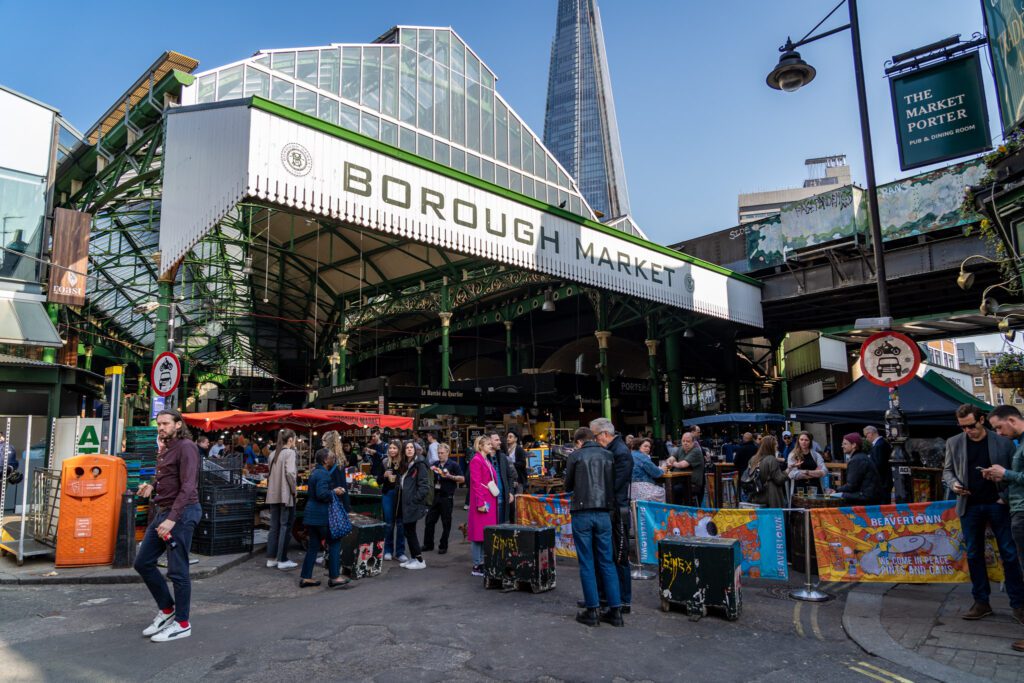
Borough Market, dating back (almost unbelievably) to before the 12th Century, is one of the largest and oldest markets in the city.
Despite being crowded and very touristy, Borough Market is one of our favorite places in the city, full stop.
However, we would caution you about coming here on a weekend, which is when the number of people here peaks and it is a ZOO.
Avoid making this day your Saturday (or Sunday, when the market is closed), if you can.
There are a couple of sections of the market, not to mention the countless bars and restaurants lining the streets around the market.
You should know that Borough Market is VERY MUCH a lunch destination – it closes in the late afternoon. And it’s closed all day on Sunday, so make sure this falls on any other day of the week.
Essentially, the market is split into two main sections: the ready-to-eat food section (which is where you should eat lunch), and the gourmet food items section.
The latter features stands selling everything from English cheese, to tea, to all things Italian, and just about everything else a foodie could dream of.
If you’re looking for coffee, Monmouth Coffee is great, and has a location right outside the western edge of the market (here on Google Maps).
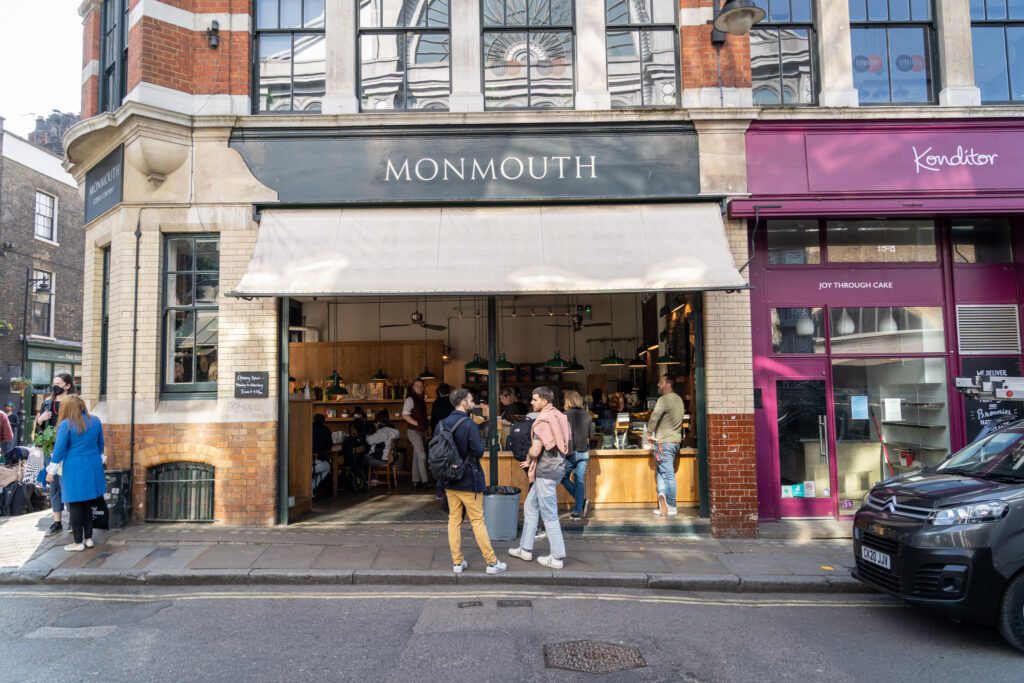
Take some time to wander through that section of the market and, when you’re ready for food, head over to the section with all the food stalls for lunch.
We found ourselves here not once, not twice, but three different times over the course of our time in London.
Here are the places we fell in love with, in no particular order.
- Khanom Krok: One of my favorite meals in London on this last trip was the pad thai from this stand at Borough Market, with the mango sticky rice for dessert. I returned a second time to try their Massaman curry, too, which was almost equally delicious (I still prefer the pad thai). Make sure to squeeze plenty of lime!
- The Black Pig: Amazing pork sandwiches that Alysha demanded to return to on our last day in London. The line here can be nuts. Get the Honey Truffle Parmesan, which is made with slow roasted pork shoulder, honey-truffle mayo, slaw, and aged parmesan. YUM. DEFINITELY NOT GLUTEN FREE.
- Horn OK Please: Vegetarian Indian street food, including dosas and amazing chai. Matt ate here three times, and would do it again in a heartbeat. Gluten free and vegan options.
- Tacos Padre: We’ve had some pretty mediocre tacos around the world, but I would put Tacos Padre somewhere near the top of the list of the best tacos I’ve ever had outside of California and Mexico. The lamb barbacoa and the cochinita (a pork slow cooked with achiote) were outstanding.


After lunch, there’s one more stop that we highly recommend at Borough Market – the Cider House.
They have a great selection of hard ciders, both on tap and in bottles, to try.
Most are from English cider producers, but we also found offerings here from New Zealand, France, and South Africa. The friendly staff will help you figure out what kind of cider to try based on your tastes.
A Walk Along the South Bank of the Thames
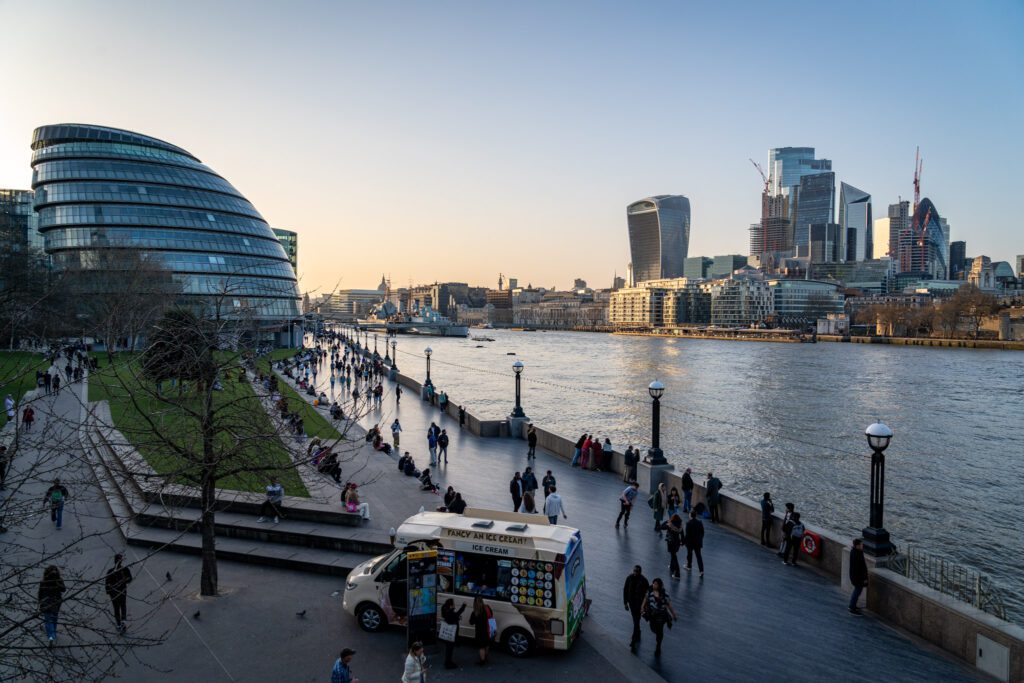
When I touch down in London, I’m generally jetlagged and tired from a long flight from the west coast of the US.
To combat that jetlag and stretch my legs, I head out to the southern bank of the Thames and walk from Tower Bridge to Westminster Bridge (home of Big Ben), past places like Borough Market (worth a stop for food!), the Tate Modern, and Millenium Bridge.
This stretch – about three miles or so – is my absolute favorite part of London for an early morning (or evening) walk, it’s packed with things to do, see, eat, and drink.
From Borough Market, make your way all the way down the river to Westminster Bridge, which should take you the better part of a few hours, including stops for a museum, a drink, a bookshop, a snack, and whatever else piques your interest along the way.
Here are the main stops along this stretch of river.
- Shakespeare’s Globe Theatre: For over 500 years, England has been a powerhouse in the world of theater, thanks in no small part to William Shakespeare. A visit to The Globe, a stunning recreation built close to the original Elizabethan theater, gives you the chance to travel back in time and experience a performance. Even if you’re not a fan of theater, The Globe is absolutely worth a visit. The circular outdoor venue hosts productions between April and September, with some of the UK’s most talented actors performing modern (and traditional) interpretations of Shakespeare’s works.If you do want to catch a show, check the schedule here and find a place to fit it in on your itinerary.
- The Tate Modern: Located at the former Bankside Power Station, the Tate Modern is well worth a visit as you wander along the waterfront. The Tate Modern is England’s national gallery dedicated exclusively to modern art. The permanent collections are completely free of charge to view, and include an impressive selection of art from the likes of Picasso, Rothko and Monet. On the 10th floor of the Tate’s Blavatnik Building is an open terrace with fantastic views across the city to St. Paul’s and Canary Wharf.
- Millennium Bridge: Just outside the Tate, this bridge is in this guide for one reason – the excellent view across the river to St. Paul’s Cathedral. It’s one of the best views in London, and is worth a slight detour to catch it. It’s here on Google Maps.
Here are a few other stops along the river bank.
- Foyles Bookshop: This is one of the best bookstores in London, and they have a location on the ground floor of Southbank Centre, right before you get to Jubilee Bridge (if you’re heading southwest).
- Southbank Centre Food Market: This was a happy accident. It’s Friday-Sunday only, so skip it if this day happens to be a weekday. We walked by it on a walk down the river and discovered Pabellon, our favorite arepa place in London. Arepas are basically a sandwich made between two corn patties that comes from Venezuela. Seriously, go here. It was so good we went back three times. There are plenty of other food stalls here, and there’s also a nice outdoor courtyard with food and shopping called “Gabriel’s Wharf” a little ways back (here on Google Maps) that is worth poking your head into.
- The London Eye: The London Eye is a little overrated, if we’re being honest. We’ve done it before, but opted out on our latest trip. It’s a little expensive, the lines are long, and the view from the Tate Modern viewing platform – which is free – is a little better. If you have kids, this is a fun experience. If not, we’d probably skip it and spend time elsewhere.
Once you’re at London Eye, you’re essentially at Westminster Bridge. You’ve already seen that if you followed the first day!
Dinner and Drinks at Mercato Metropolitano
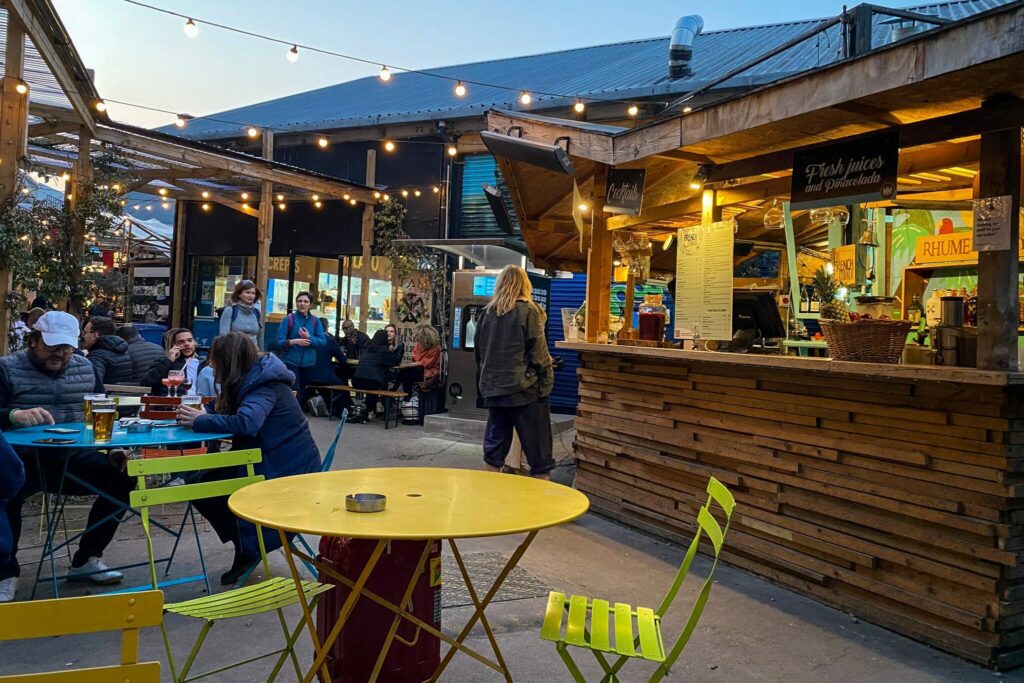
To close out your day, head south of the river to another of our favorite discoveries in London, Mercato Metropolitano.
This place is fantastic, and is essentially a big food hall with indoor and outdoor seating (in an atmospheric garden) and a huge variety of different food stalls… all attached to a beer garden!
From Sicilian arancini and granita (two of our favorite discoveries on our Sicily road trip) to Venezuelan arepas, there are options for basically everyone here, which makes it a good choice for groups.
It’s a very, very popular spot – it was packed full to the brim on a Thursday night when we were there – and there are a bunch of different options to grab a drink.
We’d recommend getting there a little early to snag a table, and hanging out and soaking up the atmosphere until you’re ready for dinner.
Day 4: A Foray into North London (Camden and Notting Hill)
On your last day, venture out of Central London and head north (it’s really only 20 minutes or so, nothing too crazy) out to Notting Hill.
From there, make your way along the Regent’s Canal to Little Venice, and finally stroll into Camden, with a stop for the view at Primrose Hill on the way.
Notting Hill and Portobello Road
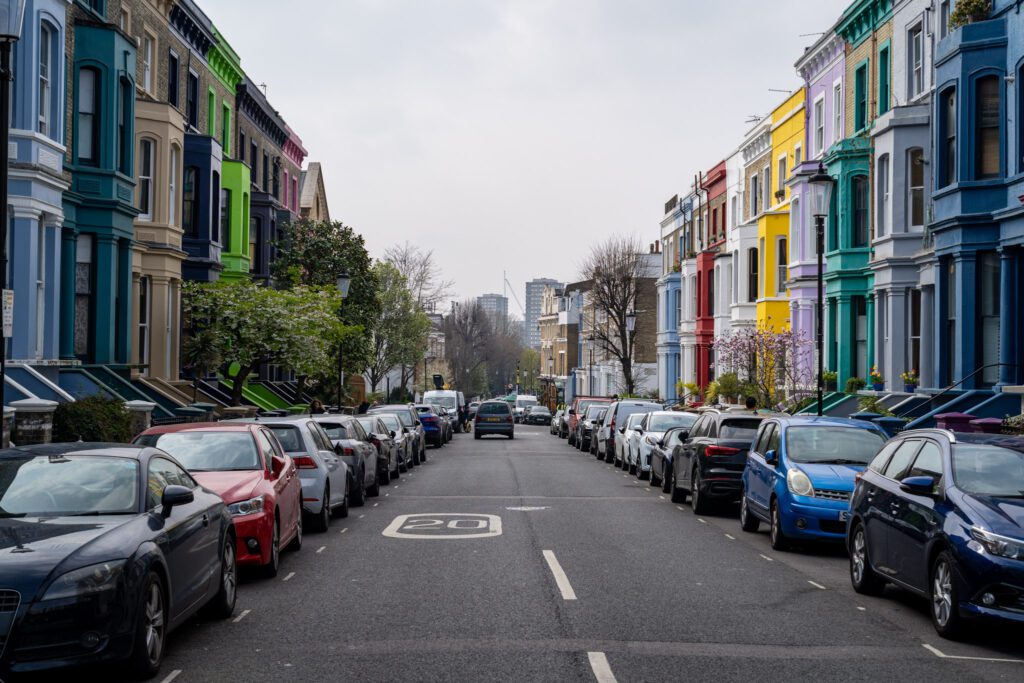
Start your morning in Notting Hill at Notting Hill Gate station, which is serviced by the Central District, and Circle Tube lines.
From there, embark on a self-guided walking tour of one of London’s most charming neighborhoods, made famous by the movie of the same name.
You’ll essentially follow Portobello Road all the way through the neighborhood from south to north, which will take you to both highlights here – the Portobello Road Market, and the colorful houses at the other end of the neighborhood.
The Portobello Road Market is best on Saturdays, when the streets are packed with vendors.
But it’s worth a stroll on other days of the week too, particularly Fridays. It’s part food market, part antique market, and part everything else market.
At the northern end, leave Portobello Road and head to the two most photogenic parts of the neighborhood, where you’ll find those colorful homes that have made this area Instagram famous in recent years.
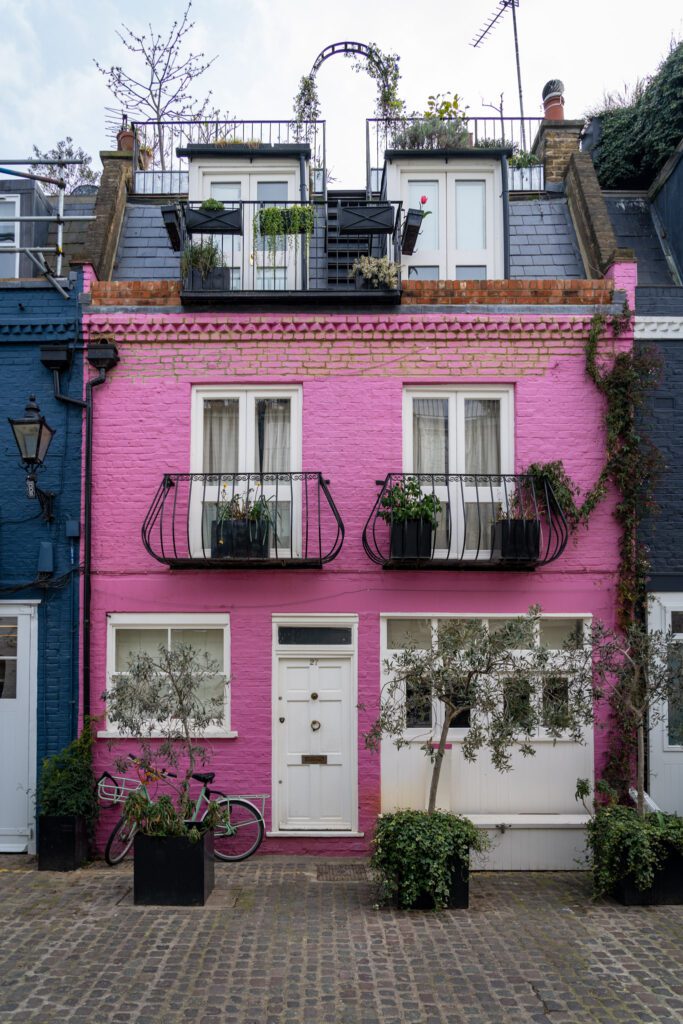
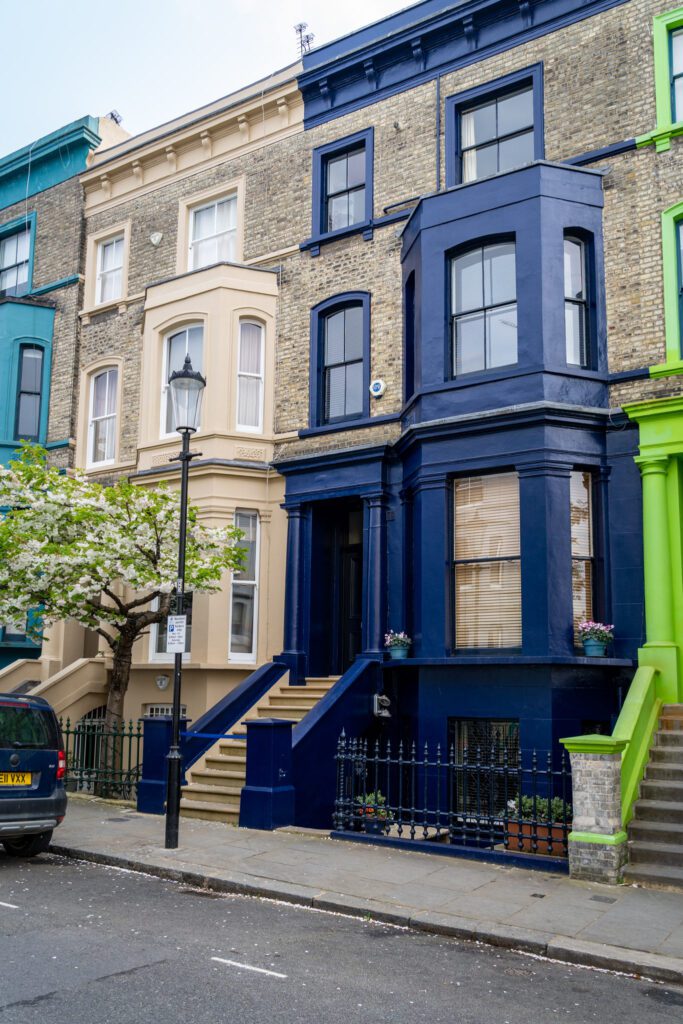
Both areas are literally a block away from each other – Saint Lukes Mews is a colorful back alley, and Lancaster Road is where you’ll find the multi-colored houses (which remind us of the famous Victorians in San Francisco, where we met, lived for a decade, and got married!).
A Walk Along Regent’s Canal
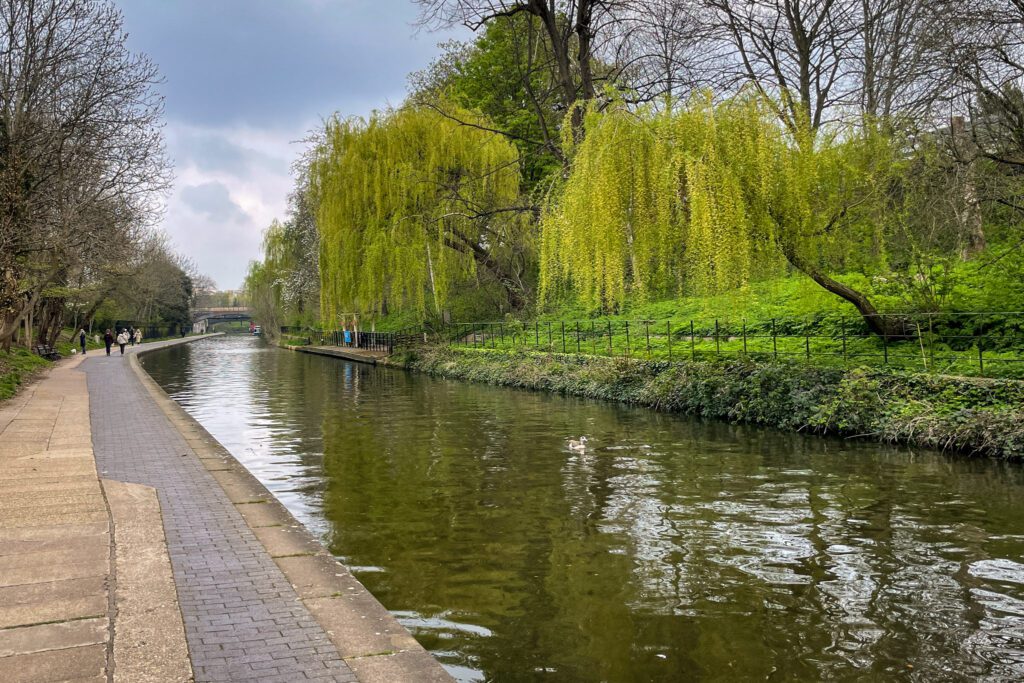
This next section is optional, and is best for people who are up for a nice walk. It’s sometimes scenic, sometimes a little boring.
If that doesn’t sound like something you’re interested in, take the Tube to Camden and skip this section.
We actually walked all the way from Notting Hill to Camden along Regent’s Canal, which took a couple of hours and led us through Little Venice, which is easily the most picturesque piece of the walk.
Near the end, you’ll be walking across the canal from the London Zoo in Regents Park, and you can see the giraffes, warthogs, and African wild dogs from the path.
Camden Market (and Camden Town)
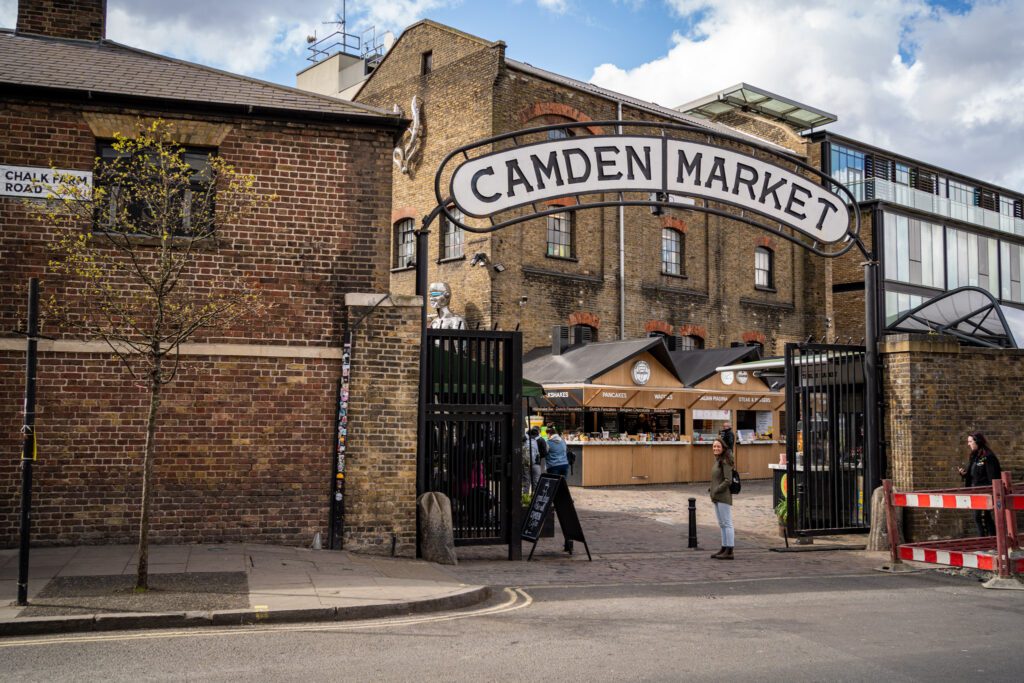
Camden is a fascinating area, and we spent a third of one of our recent trips staying here to soak it all up.
Punk music was essentially born in this part of London, and that part of the neighborhood’s character is still very much front and center, with a variety of eclectic shops blasting heavy metal music lining Camden High Street.
However, the highlight here is London’s most-visited food market, Camden Market.
Situated right on Regent’s Canal, Camden Market is a sprawling complex of shops, food stalls, and more permanent restaurants.
There are several sections of the market, but the best part is on the north side of the Canal (here on Google Maps).
The market is overwhelming, with all sorts of smells and sounds attacking your senses, but it’s well worth wandering a bit to take in everything it has to offer, from Indonesian curries to heavy metal-inspired t-shirts.
It feels like it just keeps going and going, and the scale of the market is pretty staggering.
Here are a few of our highlights that, unsurprisingly, heavily focus on food.
- El Pollote: Excellent (and gluten free!) guava-glazed chicken wings and sandwiches (the latter is not gluten free).
- Makatcha: Honestly, both the beef rendang and chicken coconut curry that I had at this Indonesian stand (on different days – they also have a stand at Broadway Market) probably make the top 10 bites of food I had in London.
- Arepazo / Arepa Venezuelan Kitchen: To be honest, I don’t know what the name of this stand is. But I do know that it’s the place to get arepas at Camden Market. The pabellón, a pulled beef, was some of the best we had in London, and the vibes at the stand with the blasting music and dancing chef were awesome.
- Kolkati: Not gluten free, but Alysha saw them at Broadway Market (another market worth visiting) and decided she had to have it. So she finally got it here at Camden Market. They make kati rolls, which are a street food staple of Kolkata that consists of fillings (either meat and accouterments or paneer) wrapped in bread.
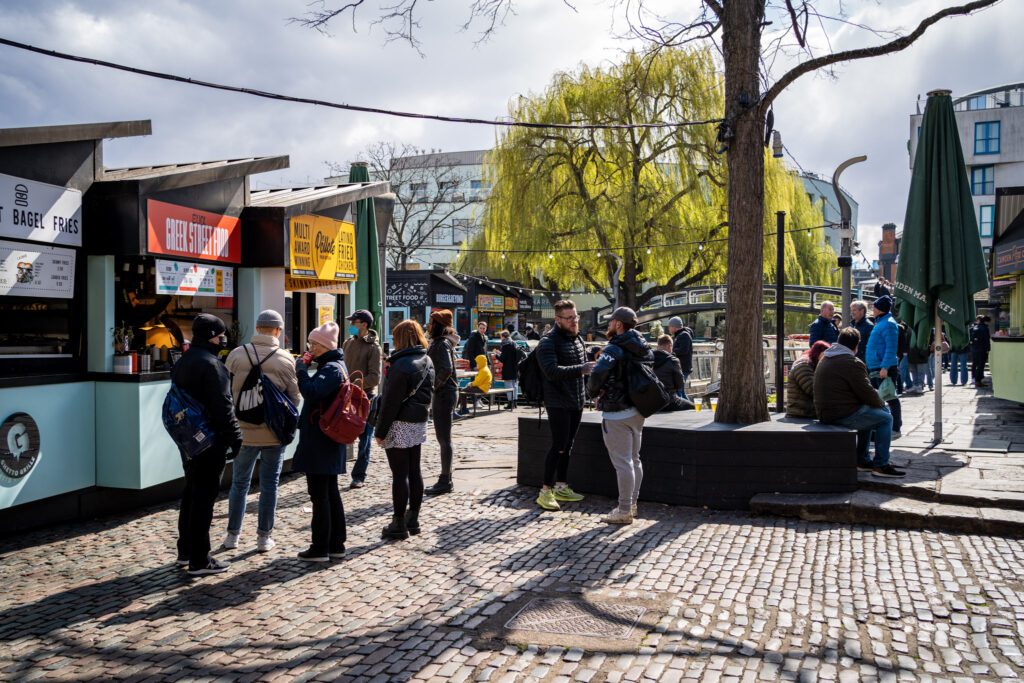

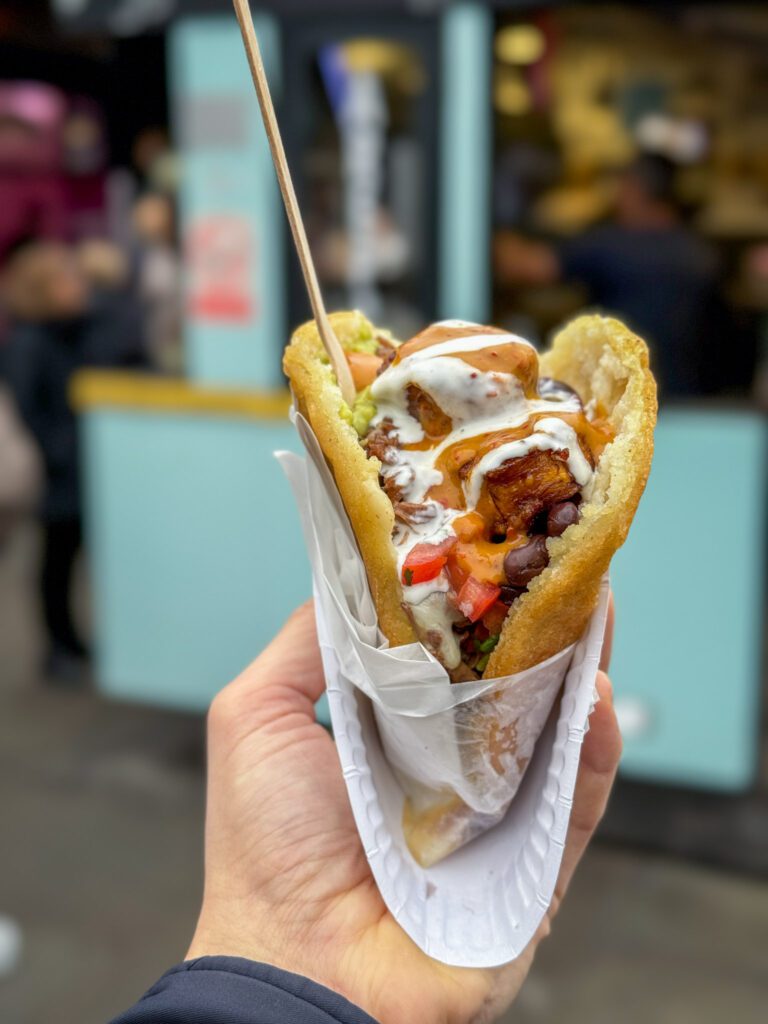
Primrose Hill
A short walk away from Camden Market along Regent’s Park Road (to the west), you’ll find two of the once commonplace bright red British phone boxes, and after a classic photo opportunity, you’ll see that you’ve reached the entrance to Primrose Hill park.
Primrose Hill is a wonderful place to spend a sunny couple of hours.
You won’t find many tourists in this part of London, just lots of locals lounging in the sun or taking in the amazing vistas from this perfect vantage point, where you’re able to see nearly every famous building in the city.
After Primrose Hill, you’ll be well into the afternoon of your last day in London.
For the evening, we’d recommend grabbing dinner and drinks in a place that you’ve already visited, but wanted to spend more time.
Catch a Show!
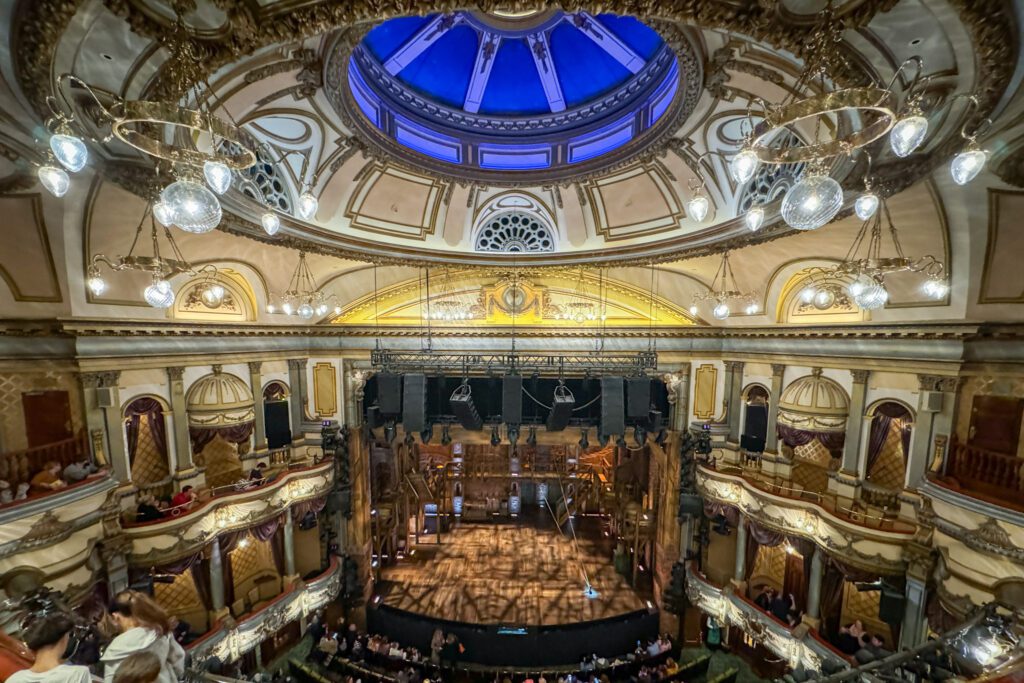
We’d also recommend using this evening to catch a show, either at the Globe Theatre if you want a unique experience, or somewhere in the West End if you’re looking to see one of the more famous contemporary shows.
On my last trip to London, aside from doing a day trip, another big thing I wanted to make sure to do was catch a show.
We actually ended up catching two shows – Hamilton (which was significantly cheaper than the touring version at home) and Operation Mincemeat, a comedy musical about an operation in World War 2 featuring a five person case playing a BUNCh of different roles (it’s very fun).
At home, we’ve seen Hamilton, Wicked, Moulin Rough (my favorite of the bunch), Book of Mormon, and Lion King, and Harry Potter and the Cursed Child, and we’d recommend all of them (although Book of Mormon probably isn’t for kids or people who are easily offended – sorry mom).
Check out what shows are happening in London while you’re in town here.
What to Do with More Time in London
Here are a few things to add to your itinerary if you happen to have more than four days.
Take a Day Trip!
One of the best parts about the UK being a relatively small country in terms of area is that there are a pretty wide variety of great day trips that are accessible from London.
As I already mentioned above, we had big plans on our two week trip a few years ago to get out of the city and see some other parts of the country… and we ended up spending the entire two weeks in London.
On this latest trip, I made it a high priority to get out of the city, and we ended up with a shortlist of three potential day trips: Oxford, Cambridge, and Bath.
On our first few days, I asked everyone I could find (tour guides, baristas, bartenders, etc etc) which of the three they’d recommend for our particular interests.
We immediately struck Cambridge from the list because the first three people I talked to said some version of “it’s basically a worse Oxford” (from a tourist perspective – their words, not mine).
The choice between Oxford and Bath largely comes down to your particular interests.
Bath is further, and has some really nice architecture, particularly Georgian architecture (multiple people said fans of Jane Austen love Bath).
And, of course, there are the Roman baths that the city is named after.
We ultimately chose Oxford, which is about an hour away on the train and is a beautiful small town with tons of stone architecture and a rich history and culture as one of the oldest universities in Europe.
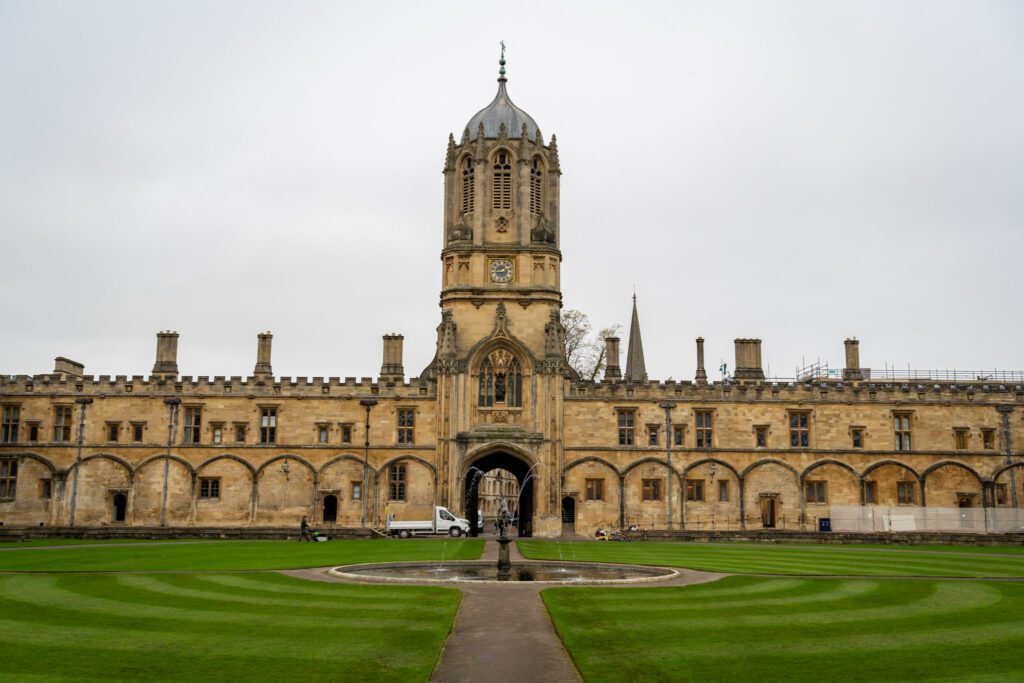
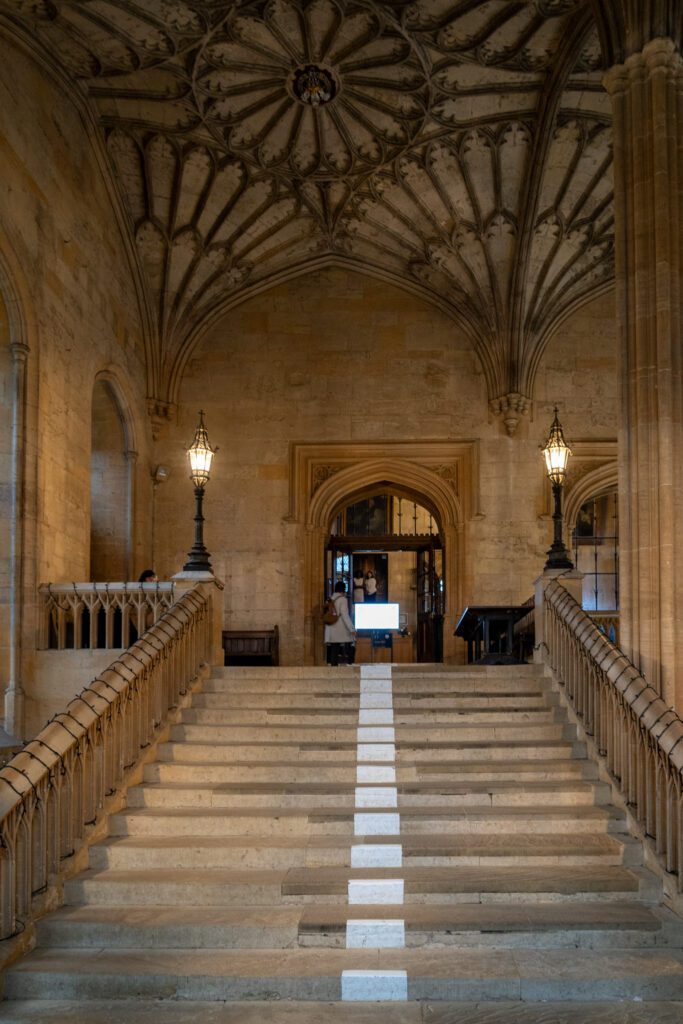
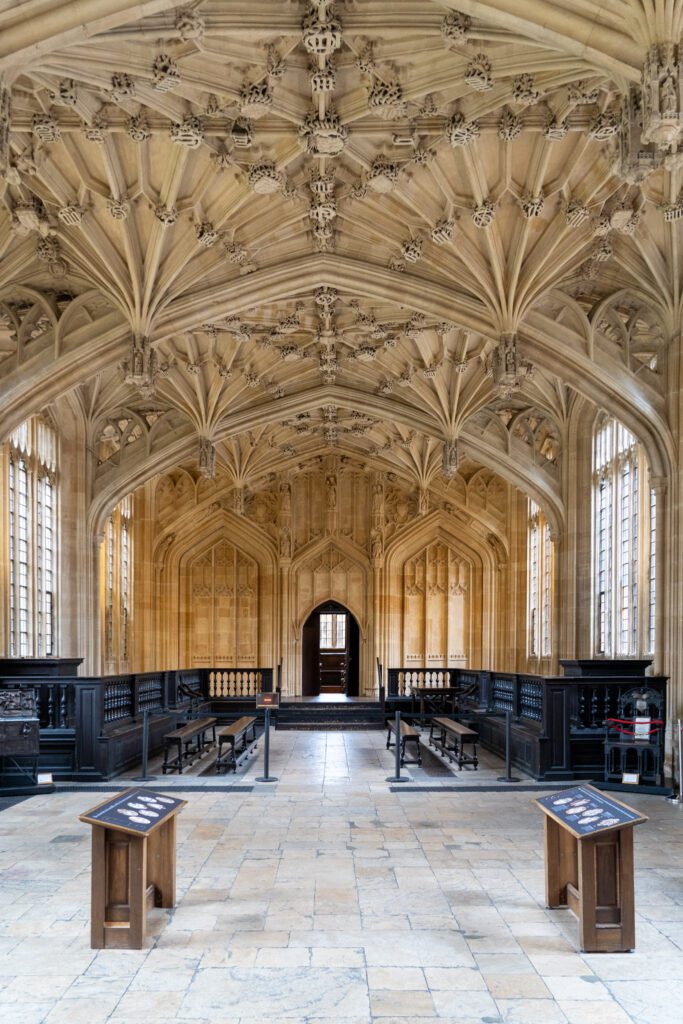
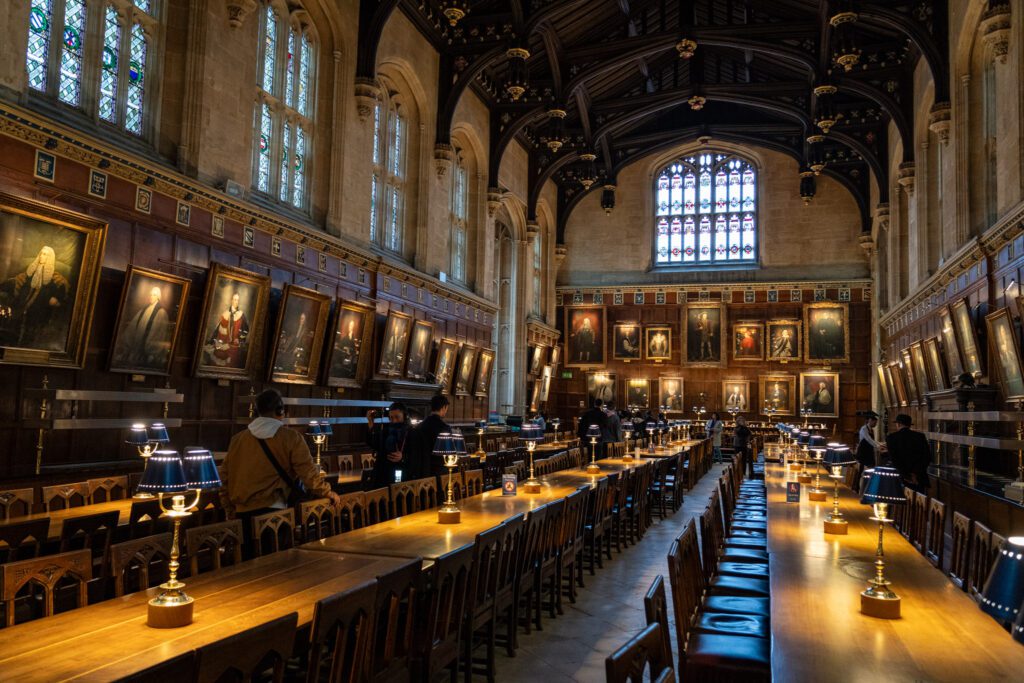
We’re also big Lord of the Rings nerds, and J.R.R. Tolkein was at Oxford as a professor as he wrote The Hobbit and the Lord of the Rings trilogy.
Another point in Oxford’s favor. And we love Harry Potter, and parts of the movies were filmed in Oxford.
If you do go to Oxford, I highly recommend a guided tour of the campus (we did this one, which is led by Oxford alumni AND includes Christ Church, where parts of Harry Potter were filmed), which will give you A LOT more insight into the specific history and culture behind what is one of the most famous universities in the world.
Catch a Soccer (Football?) Game
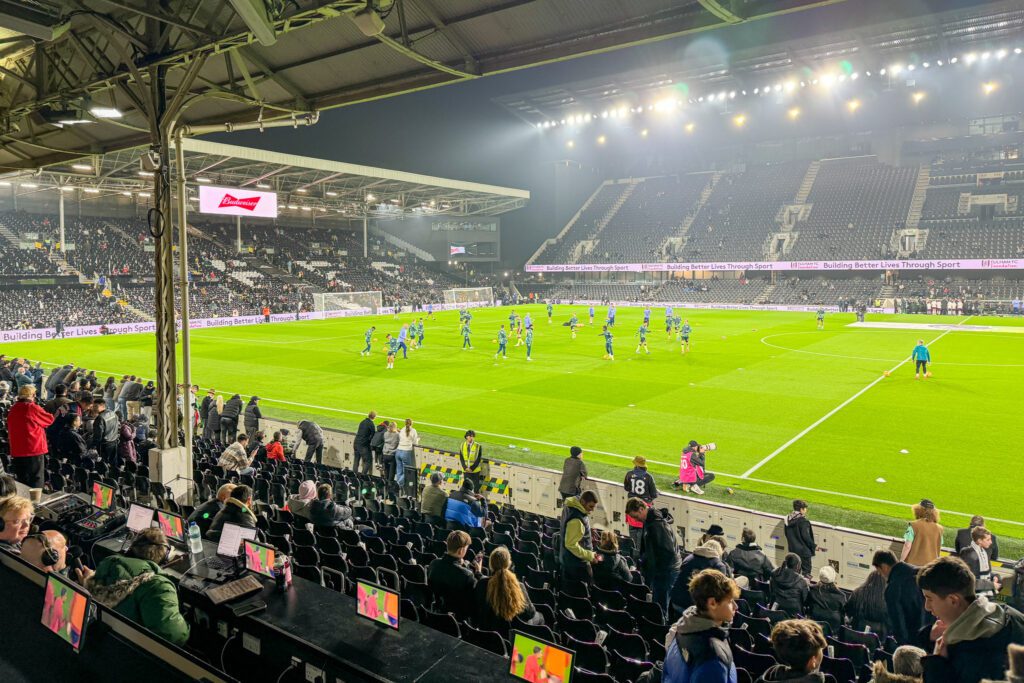
In addition to high fantasy, another thing that I’m passionate about is soccer. Or football, as it’s called in the rest of the English-speaking world.
I’m quite literally sitting here at home writing this section with a Premier League game on in the background.
The big reason for this latest trip was to catch a few Premier League games with my brother, who is a West Ham fan (COYI).
I support Brentford, so we did our best to see both (and succeeded).
The first thing you need to know is that Premier League tickets are heavily regulated, and the secondary market is somewhere between nonexistent and illegal (depending on who you talk to) in an effort to preserve prices for season ticket holders.
Which means tickets are harder to get than you might be used to if you’re coming from an American context.
On the bright side, you’ll find that tickets are SIGNIFICANTLY more affordable than they are in the US. On the not-so-bright side, it’s definitely more complicated to get them, especially for big Premier League games.
Here’s the gist of it: Tickets are released in waves, first to season ticket holders, then to members, then to previous purchasers, then to the general public (or some variation of this).
To get tickets to a game, you have a few options.
- Become a member of the club (by paying their membership fee – usually around £50) you want tickets for ahead of time, and then wait for tickets to be released to members.
- Wait until tickets go on sale to the general public and hope that there are still some available.
- Purchase a “hospitality package” that includes some extras and comes at a higher price and skips all of the minutiae above (P1 Travel was the recommended company).
Generally speaking, it is easier to get tickets to lower league games (teams in the Championship of League One, two lower tiers of English soccer) than it is for Premier League games.
I’ve been to Craven Cottage, home of Fulham (and a few good American players over the years, like Clint Dempsey and Antonee Robinson) twice now, and love the intimate nature of the stadium (the front row of seats are basically on the pitch) and the location on the river.
We also went to the London Stadium to see West Ham, which was far less charming and interesting (though it’s huge).
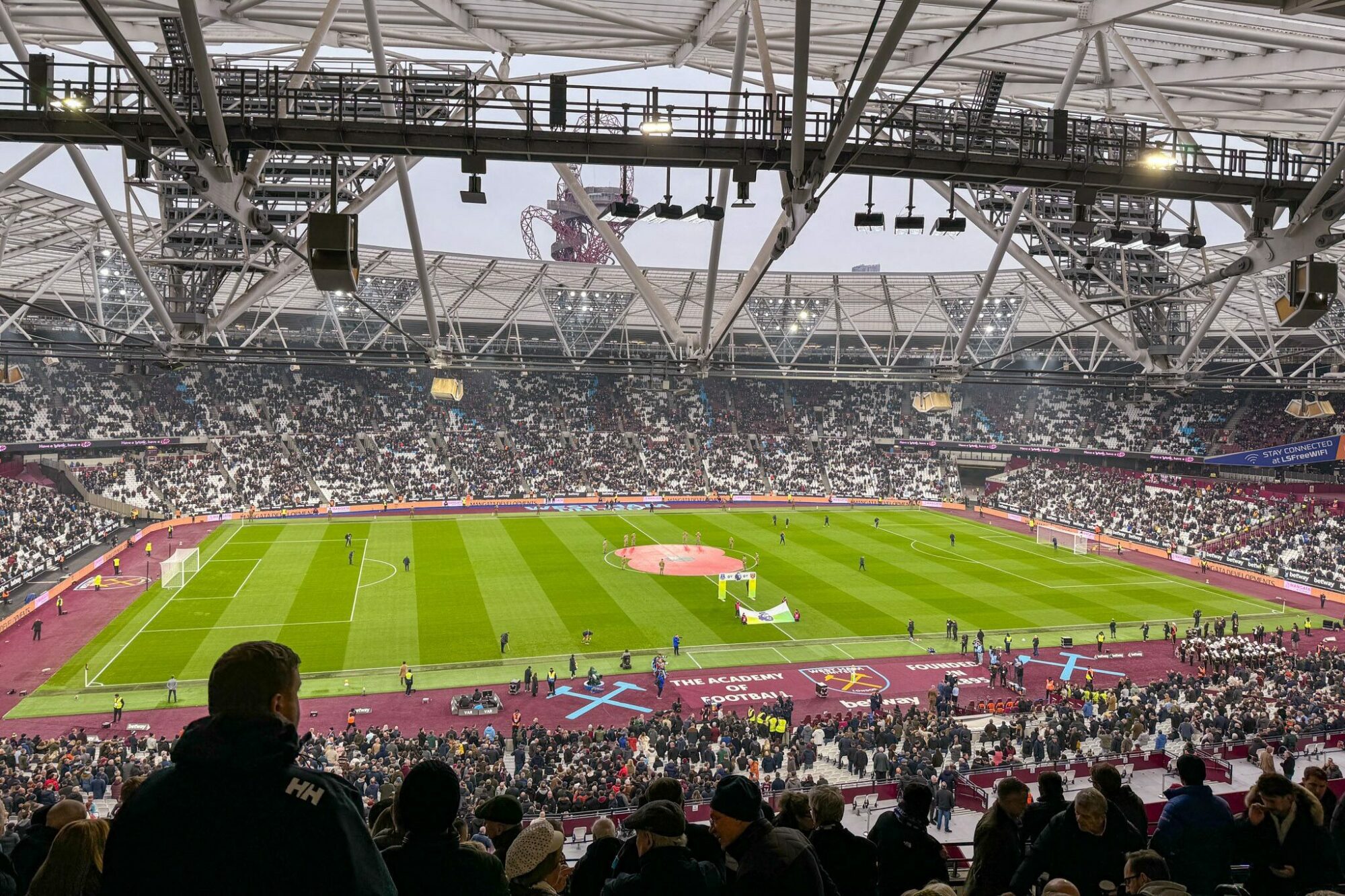
Other clubs to look at other than the big ones (Tottenham, Chelsea, and Arsenal) would be Crystal Palace, Leyton Orient, and Brentford.
What to Do with Less Time in London
We had almost two full weeks in London, but we realize most people aren’t blessed with that much time to explore. Or even able to spend four days.
Here’s how we’d spend less time in London, from one to three days. You can use these overviews to get an idea of the plan, and then use the detailed sections in the itinerary above to go deeper on the places you end up including.
London in a Day
With just a day in London, you’re really going to have to pick and choose what you do and see, because a day is not nearly enough time.
But, we’re here to give you our best take on how to spend your time, so let’s talk about what a perfect day in London looks like, at least for us.
Immediately, we think you should skip the museums. The Natural History Museum and Victoria and Albert Museum are both cool, but they’re pretty far away from the rest of Central London.
The other thing you’re going to have to miss is the Changing of the Guard.
First of all, it doesn’t happen every single day year-round, so there’s a chance that it’s not even happening on the day you’re in London.
Second, having that specific time in mind makes it hard to plan the rest of the day.
Instead, focus on exploring the area around the Thames. Start your day at Buckingham Palace, the King’s part time residence (we were told by multiple people that he’s hardly ever there these days). Make your way to Westminster Abbey from there, and admire Big Ben before walking over the Westminster Bridge.
From there, make your way along the south bank of the Thames, following the walk in the main itinerary above.
Stop at Borough Market for lunch, then make your way across either London Bridge (better views, specifically of Tower Bridge and the Tower of London), or Tower Bridge (worse views, but a cool experience) and head to the Tower of London.
Finally, make your way on a walk through the city of London, and end at St. Paul’s Cathedral.
With 2 Days
With 2 days in London, you’ll need to do some swapping around of activities, but you can use the first three days of the itinerary above as a baseline.
Here’s how we’d do it.
On the first day, combine the morning of day 1 (St. Paul’s, the London Museum, and the City of London) and the morning of day 2 (Big Ben, Westminster Abbey, and Buckingham Palace).
Start with the Westminster stuff to make sure to get to the Abbey early, and end with St. Paul’s. Head to Shoreditch for dinner and drinks.
On the second day, follow day 3 as written above. If you want to catch a show while you’re in town do it on your second evening.
With 3 Days
With three days, we’d follow the itinerary above as written, and skip day 4 altogether.
While it’s a bummer to miss out on Camden Market, you’re making it to Borough Market, so you’ve got a taste of London’s food markets.
If you want to catch a show, you can add it to any of the evenings pretty easily.
Important Tips for Visiting London
Here are some tips and tricks for planning your visit to London that are probably most helpful for first timers.
As Americans, traveling to London is noticeably different than traveling to other places in Europe, like Italy or Portugal, due to the absence of a language barrier.
It feels much more similar to home, even though it’s really not. There are certainly cultural and practical differences that you’ll want to know going in.
Here are a few things that we’ve learned about London to keep in mind as you’re planning your trip.
Early Mornings are Best for the Main Sights
For sights like St. Paul’s Cathedral, the Tower of London, and Westminster Abbey, try to get there when they open. Especially on a Sunday.
Alysha went on a solo trip to the Tower of London (Matt has been multiple times before) and was surprised at how empty it was on a Sunday morning!
We had the same experience on a Thursday morning at St. Paul’s Cathedral.
In the summer, it will still be busy in the morning, but not as busy as midday or later in the afternoon.
London is Massive
We LOVE walking around cities, and think it’s the best way to experience a city. But if we’re being honest, it’s nearly impossible to walk around London – it’s just too big!
We didn’t quite understand just how massive London is until we had spent some time moving around it.
I mean, sure, we knew it was a huge city with 10 million people, but I don’t think we quite understood just how long it takes to get from one end of the city to the other.
The good news is that the public transportation network in London is excellent. You can use the buses and the Tube (the Underground) to zip around the city.
Public Transportation is Both Expensive and 100% Worth it
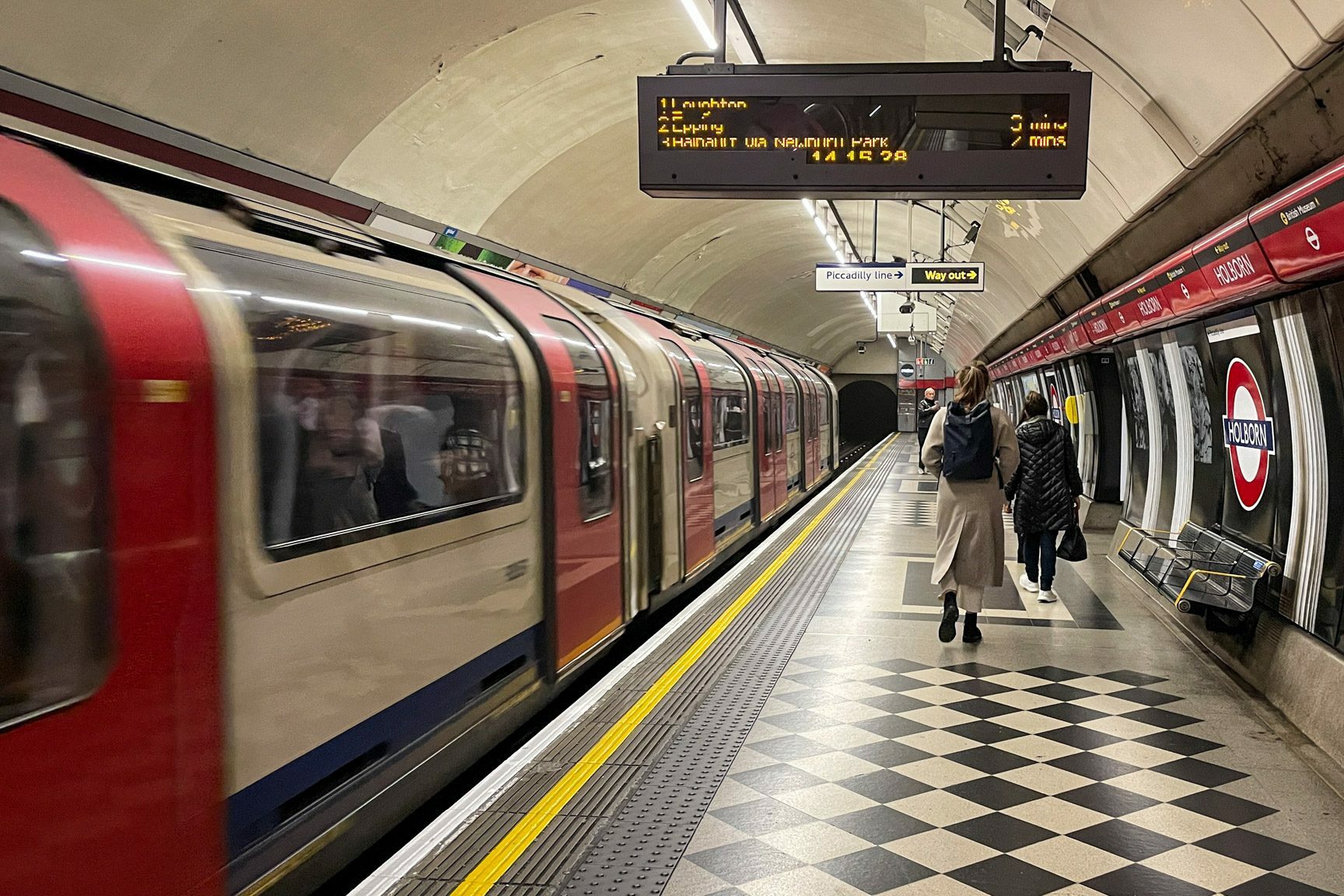
Getting around London using the Tube is fast, efficient, and is absolutely something you should take advantage of.
A lot of people balk at the £6 per ride cost of riding the Tube in London, but if you dig a little deeper, you’ll find that it’s definitely worth it.
The alternative to public transportation is taking a taxi or rideshare, which is more expensive.
And, though you’re only in London for four days, a weeklong unlimited transit pass is just £38.70, which means it’s £10 a day for unlimited access (plus £5 for an Oyster card).
For that reason (p.s., the answer can be well over an hour, depending on where you’re headed), we highly recommend investing in an unlimited public transportation card while you’re in London, which is called a Travelcard and is something you can buy at the machines at most Tube stations.
The Travelcard gives you unlimited access to the Underground and buses in London.
Both are efficient, relatively clean (coming from the US), and will get you from point A to point B far faster than your own two feet.
You’ll need to choose the duration based on your trip – one day, two days, a week. More information here.
Since you’ll likely only need zones 1-2 for most of the sights in Central London, we’d recommend purchasing your Travelcard separately from your trip from the airport, if you choose to take the Tube from Heathrow.
The airport is outside of that range, and it would increase the price of your pass substantially.
Top Travel Tip: Use the “TFL” (Transport for London) app on the Apple or Google Play store for an app with a wealth of maps, timetables and transport information.
The Museums are Mostly Free (!)
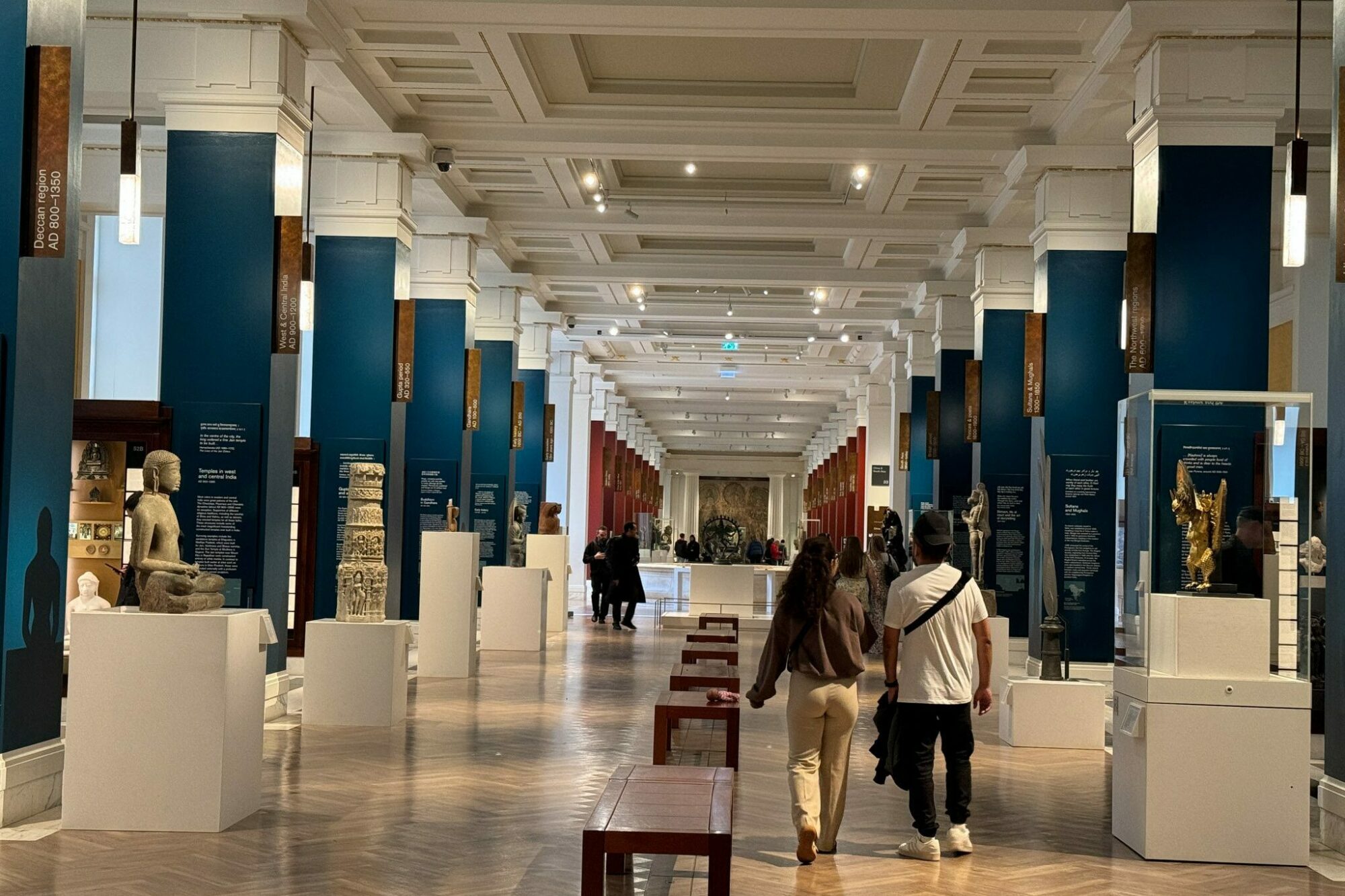
Unlike most other cities, where you’ll have to shell out a lot of money to visit the museums, the main museums in London are free.
In high season, it’s best to make a reservation for a timed entry in advance to make sure you can get in.
We love this aspect of London, because it makes it so that you can poke your head in, see if you’re really interested in something, and then decide to opt out if it’s not for you without the “we just spent £30 on this, I guess we have to stick it out” guilt.
They Drive on the Other Side of the Road
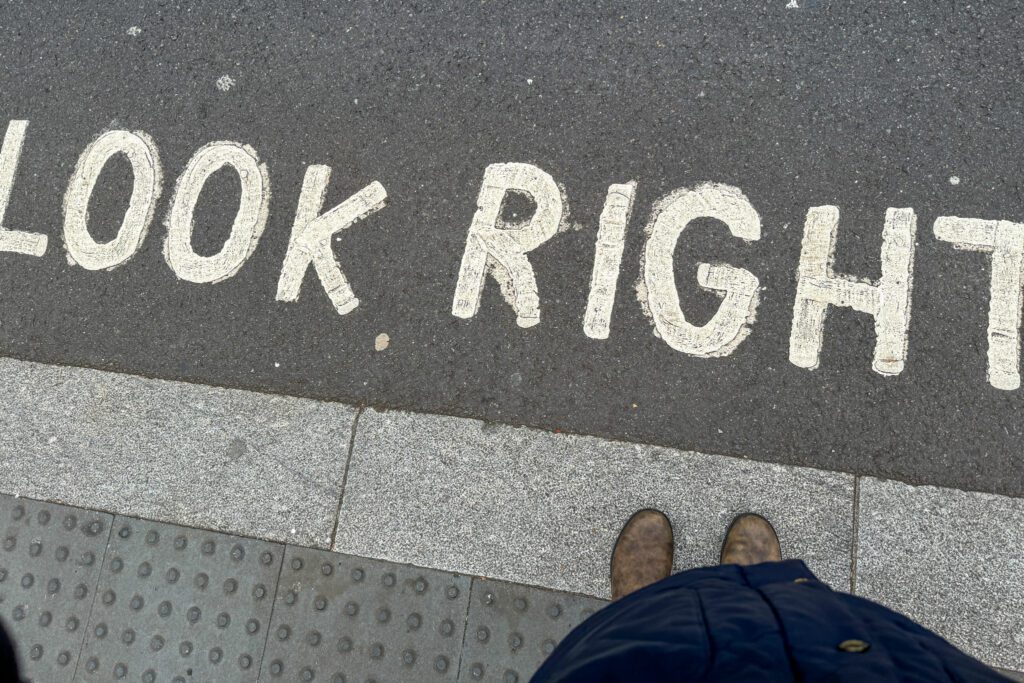
We, of course, knew this going in, but that didn’t stop us from nearly getting run over on our first few days in London on both of our most recent visits.
Luckily, in the center of London, there are helpful “look left / right” signs on the ground at crosswalks, which saved our lives multiple times.
When in doubt, look both ways. Three times.
Specific Days of the Week to Keep in Mind for Your Trip
One of the things we realized as we sat down to outline this guide is that a lot of the things to do depend on what days of the week you’re in town.
This is particularly relevant for some of the food markets.
For example, Borough Market is packed on Saturday, closed on Sunday, and great on weekdays. But only at lunchtime!
On the other hand, Broadway Market up north is really a Saturday (or Sunday, but Saturday is better) destination, when the streets are packed with vendors selling all kinds of delicious food.
Here are some considerations for days of the week to keep in mind as you’re planning your trip (there’s more detail on what exactly these places are and what they offer in the detailed itinerary below).
- Borough Market: Lunch only, Monday to Saturday.
- Broadway Market: Definitely go on Saturday for lunch.
- Camden Market: Mostly a lunch spot, and you should also go on Saturday if you can.
- Spitalfields Market: Weekends are best here, when the entire interior is lined with stalls selling food, arts and crafts, and other fun stuff to peruse.
- Portobello Road Market: The market in Notting Hill is, again, best on Saturdays, when the majority of vendors are set up.
- Columbia Road Flower Market: Sundays only!
- The Sunday Upmarket: The vintage/food market on Brick Lane is a weekends only destination, both Saturday and Sunday.
“WOW” you say, “that’s a LOT of weekend only markets – which ones do you like best?”
If we had to choose, we’d opt for the Broadway Market, which feels much more like a neighborhood farmers market than any other market we visited (and we went twice!), and the Spitalfields Market and Upmarket, which are a few blocks away from each other.
You should also definitely visit Camden Market and Borough Market, but the day of the week matters less for those (though they’re both lunchtime destinations, rather than evening destinations).
